Introduction
In a world where time is the new currency and efficiency is the linchpin of success, Robotic Process Automation (RPA) emerges as a game-changer for organizations striving for excellence. Imagine a workplace where software bots tirelessly process transactions, handle data entry, and manage customer interactions with unfaltering precision. This is not the stuff of science fiction, but the reality of RPA—a reality that is reshaping industries and redefining the nature of work itself.
As operations become increasingly complex, the integration of RPA offers a compelling solution for businesses to surmount the challenges of mundane tasks and unlock unprecedented levels of productivity. This strategic deployment of digital workers not only streamlines operations but also catalyzes innovation, allowing human creativity to flourish without the constraints of repetitive labor.
The transformative power of RPA extends across sectors, from the intricacies of healthcare and the demands of customer service to the precision of financial services and the dynamics of supply chain management. It represents a pivotal step towards a future where businesses can pivot with agility, ensuring customer satisfaction, and fostering a new era of growth and scalability.
Delve into the multifaceted landscape of RPA robotics—where the fusion of technology and strategy creates a symphony of efficiency and the blueprint for the future of operational excellence.
What is RPA Robotics?
Robotic Process Automation (RPA) stands at the forefront of business modernization, with its ability to automate mundane, rule-based tasks through software bots. These bots are adept at emulating human interactions with digital systems, providing a solution to enhance operational productivity by taking over time-consuming data entry or document processing chores. The integration of RPA can significantly augment efficiency by performing these tasks more quickly and accurately than human counterparts.
A strategic approach to RPA implementation involves a comprehensive examination of internal operations to determine which can be automated effectively. For example, GrayMatter Robotics, an AI-centric robotics firm, is transforming manufacturing with its advanced robotics and AI, highlighting the significance of identifying the appropriate processes for mechanization and the enhancements in quality it can bring.
Moreover, the industry is witnessing a surge in mobile robotics, especially in intralogistics, healthcare, and hospitality. Notably, a new wave of cost-effective mobile robotics is emerging, aimed at small and medium-sized enterprises (SMEs) looking to leverage automation without prohibitive costs. The global mobile robotics market, with an estimated value of $20.3 billion, is expected to nearly double by 2028, signaling a robust growth trajectory.
For enterprises, especially smaller ones, RPA provides a pathway to improved customer satisfaction. By expediting response times and ensuring consistent information delivery, RPA fosters customer loyalty—a critical element for growth. Additionally, the adoption of RPA should be viewed as a continuous improvement journey, constantly evolving with the business needs.
With the expansion of the robotic industry, the need for mobile robots is increasing, as shown by a study indicating that the Autonomous Mobile Robots Market is expected to achieve a value of $18.2 billion by 2032. This growth is part of a broader trend in the robotics sector, which is expected to climb to a staggering $45.09 billion by 2028. With the United States poised to lead in revenue generation, it’s clear that RPA and robotics are vital to the future of work, signifying a transformative era for industries worldwide.
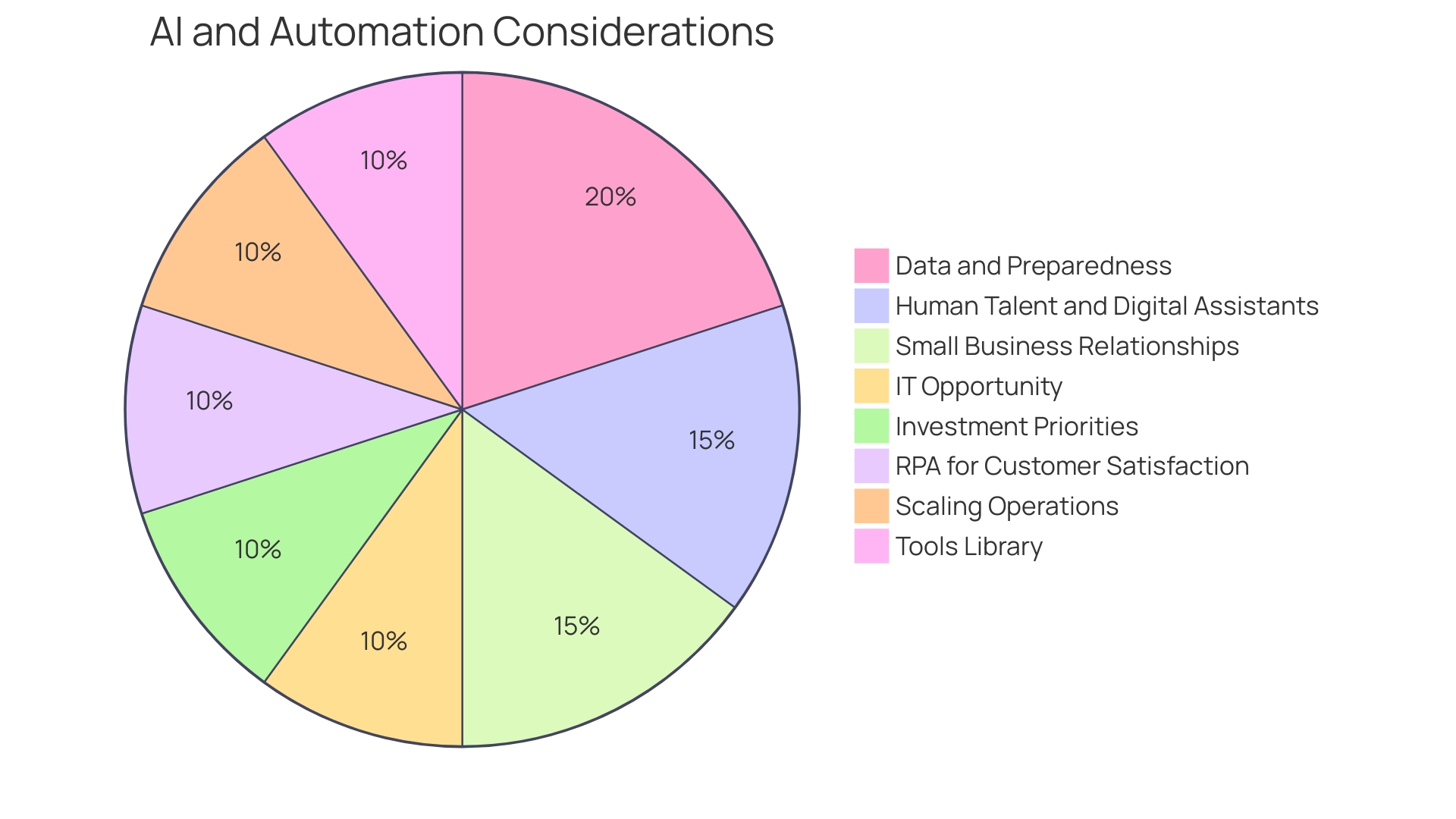
Applications of RPA Robotics
Robotic Process Automation (RPA) is revolutionizing the way companies operate across a myriad of industries. Financial services are harnessing RPA to create AI-powered knowledge assistants on platforms like AWS. These assistants provide instant, contextual answers around the clock, helping employees navigate vast data streams, from market trends to regulatory changes. In manufacturing, RPA streamlines complex supply chains, with AI elevating operational optimization by enhancing decision-making and reducing costs. Similarly, healthcare and customer service sectors are embracing RPA to automate routine tasks, thus elevating the quality of care and customer engagement. By meticulously choosing procedures for automation, evaluating inefficiencies, and calculating integration costs, these industries are not only transforming workflows but also establishing new standards in efficiency and productivity.
Automating Data Entry and Processing
Robotic Process Automation (RPA) stands at the forefront of business efficiency, enabling software robots, or ‘bots,’ to emulate and execute tasks across digital systems traditionally done by humans. These bots can adeptly manage data entry, process transactions, navigate workflows, and even handle customer service interactions. The true power of RPA lies in its ability to integrate disparate systems, liberating employees from a multitude of routine tasks.
Within the realm of data handling, RPA bots excel by extracting information from various sources, validating it, and seamlessly inputting it into corresponding systems. This degree of mechanization not only reduces human error but also greatly improves the accuracy of the data. Companies like GrayMatter Robotics are pioneering efforts to integrate AI with robotics, aiming to augment human productivity and elevate the quality of outputs across industries.
For example, St. James Winery has enjoyed the benefits of mechanization, becoming Missouri’s biggest and most honored winery. This accomplishment is credited to their careful focus on processes, where mechanization has played a vital role. Likewise, progress in clever mechanization, encompassing AI-enhanced and self-governing systems, are transforming the corporate scenery by providing different levels of complexity in human-AI collaboration.
Understanding the scope and capabilities of RPA is essential for modernizing operations effectively. Leaders must take into account crucial factors such as the appropriateness of processes for mechanization, the inefficiencies that RPA can tackle, and the investment needed for integration. The objective is to make well-informed decisions that harness the potential of RPA to drive business innovation, enhance customer satisfaction, and facilitate scalable growth for small and large enterprises alike.
Streamlining Customer Service Processes
Innovative applications of Robotics Process Automation (RPA) are transforming customer service operations by automating routine tasks, ultimately enhancing the customer experience. For instance, Medien Hub Bremen-Nordwest reported remarkable success with their AI platform, Parlor, in partnership with SC Soft, where their Voicebot significantly reduced complaint processing times, immediately benefiting their customer satisfaction metrics.
RPA’s potential in improving customer service is further demonstrated by Rippling, which supports over 400,000 users. After moving away from a decision-tree-based solution, they adopted a more sophisticated AI agent solution, resulting in more accurate and time-sensitive responses, crucial for their HR, Payroll, and IT management services.
The retail industry’s move towards mechanization has been notable, with many retailers implementing chatbots and interactive voice response systems to manage high volumes of customer inquiries. This advancement not only boosts efficiency but also generates cost savings by handling routine tasks like order status checks and shipping updates.
According to recent market data, the expansion of companies specializing in logistics, particularly through mobile robots, has surged by 45% in Spain between 2012 and 2022. This trend underscores the expanding role of automation in various industries beyond traditional sectors like automotive, where approximately 50% of Spanish robots are utilized.
As enterprises adopt hyperautomation, they are urged to consider it as an ongoing expedition, consistently enhancing workflows to optimize advantages and stay in line with the future of labor. By prioritizing customer relationships and scaling operations efficiently, small businesses can leverage RPA to respond swiftly and accurately to customer inquiries, fostering loyalty and satisfaction.
Enhancing Financial Operations
Robotic Process Automation (RPA) is transforming the landscape of finance and accounting operations. By deploying bots to handle routine tasks such as invoice processing, accounts payable, receivable, and financial reporting, companies are experiencing a significant uplift in efficiency. These automated systems are not only enhancing accuracy but also cutting down on processing times dramatically.
The integration of RPA into financial departments is not a straightforward task, though. It requires a strategic approach, starting with identifying which manual processes are ready for mechanization. Companies must then pinpoint the inefficiencies that RPA can resolve and weigh the time and costs of integrating RPA software against the potential return on investment. Moreover, the existing software infrastructure must be evaluated to ensure compatibility with RPA solutions, addressing any limitations before moving forward with implementation.
Despite these considerations, the benefits of automating finance functions cannot be overstressed. A study using the Total Economic Impact⢠methodology developed by Forrester Research demonstrated that investing in intelligent technology resulted in a 73% increase in net present value advantages and a 5.4% compound annual growth rate over three years for a composite organization. These numbers underscore the transformative potential of RPA in financial operations.
Moreover, industry leaders recognize that while mechanization is a game-changer, it necessitates a continuous human-machine partnership. Continuous monitoring, management, and upgrades are essential to maintain stability and realize the full benefits of RPA. As the CTO and Co-Founder of Reveille Software puts it, AI and machine learning, integral to RPA, are designed to bolster efficiency, productivity, and convenience, but the human element remains pivotal for ensuring success.
In the realm of financial operations, mechanization stands as a powerful tool to shift the focus of finance teams from mundane tasks to strategic initiatives. As Razzak Jallow, CFO of FloQast, notes, the role of the CFO has evolved from tactical to strategic, thanks in part to the rise of innovative technologies like RPA. Similarly, Shagun, CEO of System, highlights the untapped potential for automation in finance departments, with 80% of financial operations primed for automation according to Accenture, signaling a significant opportunity to refocus employee efforts on value-adding activities.
This synergy of RPA and strategic human oversight is reshaping finance departments, propelling them towards a future where strategic activities take precedence over routine transactional tasks.
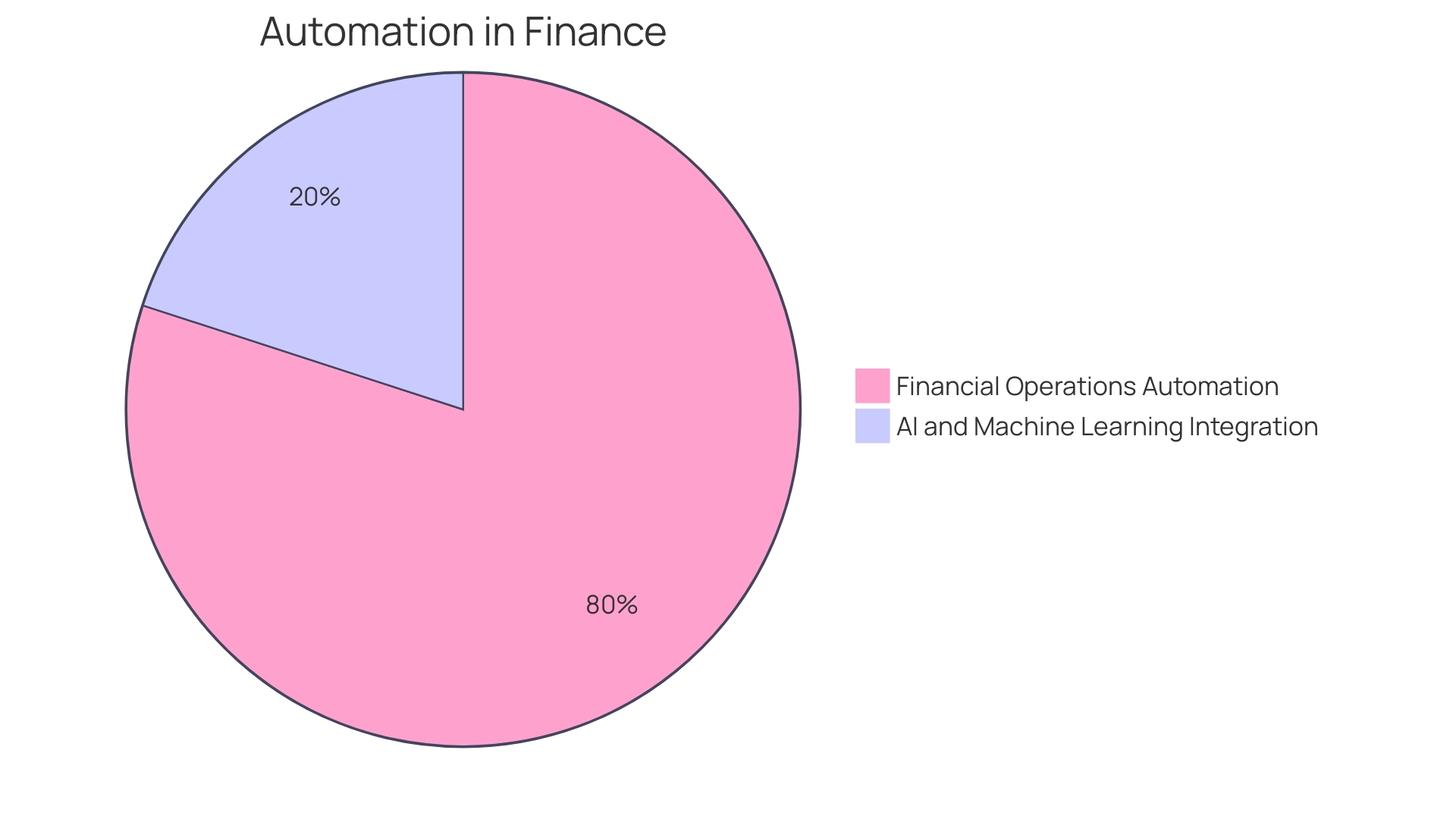
Improving Supply Chain Management
Robotic Process Automation (RPA) is revolutionizing supply chain management, offering unparalleled efficiency in handling routine tasks such as inventory control, tracking orders, and managing supplier relationships. By leveraging RPA, businesses can synchronize data, generate insightful reports, and foster smooth interaction among various supply chain participants. The integration of RPA into supply chains is exemplified by success stories like Zara, which has implemented AI across its operations, including inventory management systems, to stay ahead in the competitive fashion market. Utilizing technologies such as RFID and real-time analytics, Zara has crafted a Just-In-telligent supply chain that optimizes inventory levels and logistics in real-time.
In the sphere of public services, innovative solutions like Tungsten TotalAgility are transforming operational processes, enabling richer data capture from transactions. This movement towards mechanization not only improves customer service but also promotes customer satisfaction and loyalty. Furthermore, in the logistics industry, the emergence of cost-efficient mobile robotics, like the ReBeL on Wheels, is making access to mechanization more accessible for small and medium-sized businesses. These robotic solutions are becoming increasingly prevalent, with the global market for mobile robotics expected to nearly double by 2028, signifying their importance in intralogistics and other industries.
The game-changing potential of mechanization in supply chain management is highlighted by industry research suggesting that substantial investments in warehouse mechanization have resulted in advantages such as enhanced productivity, better customer demand fulfillment, and cost savings. Nevertheless, it is essential for businesses to specify their mechanization goals, comprehend the trade-offs, and select the appropriate technology based on nuanced comprehension and evaluation of diverse scenarios, including potential for future expansion. As such, RPA in supply chain management is not a static solution but requires continuous monitoring and management to ensure it aligns with the dynamic demands of the market.
Benefits of RPA Robotics
Robotic Process Automation (RPA) stands as a transformative force across various sectors, from recycling facilities to the hospitality industry, and even in the world of fine wines. For instance, Millennium Recycling, a material recovery facility, leverages RPA to enhance its recycling processes, showcasing the technology’s adaptability to environmental services. Similarly, the Louvre Hotels Group has reaped substantial efficiency gains by implementing RPA in rate code maintenance, saving hundreds of hours monthly that can be redirected to more strategic tasks.
Moreover, the impact of RPA is evident at St. James Winery, where the integration of mechanization supports their award-winning production, affirming RPA’s role in preserving craftsmanship while improving operational efficiency. These case studies exemplify how RPA can revolutionize time-intensive tasks, enabling companies to focus on innovation and growth.
RPA’s capabilities are further emphasized by the significant presence of service robotics at global events like CES, where the newest advancements in technology are on full display. Service robots, classified for personal or professional use, are becoming increasingly integrated into various service industries, including agriculture, logistics, and medical fields, signifying a broader shift towards automation.
The technology’s adoption is not limited to large enterprises; small enterprises also stand to benefit immensely. By automating routine, rule-based tasks such as data entry and document processing, RPA enables these enterprises to maintain and even enhance their customer relationships through quicker response times and consistent, accurate information delivery.
Considering these advancements, leaders contemplating RPA implementation should reflect on the specific processes ready for streamlining, the inefficiencies to tackle, and the integration costs. With the potential for significant economic impact, including a 73% net present value benefit and a 5.4% compound annual growth rate over three years, RPA promises a future where operational excellence and customer satisfaction go hand in hand.
Increased Efficiency and Productivity
RPA Robotics transcends traditional productivity measures by enabling round-the-clock operation without breaks or errors, revolutionizing the way tasks are approached. Companies can now redirect their workforce to strategic and creative pursuits, enhancing the value they provide. Millennium Recycling, a leader in the recycling industry, has utilized cutting-edge technology to become one of the most efficient material recovery facilities, embodying the transformative effects of advanced machinery. Similarly, St. James Winery’s commitment to innovation has cemented its status as Missouri’s most celebrated winery.
Recent challenges in Europe, such as the skilled worker shortage, particularly among SMEs, underscore the urgency for solutions like RPA. Robots not only boost productivity but also alleviate the workload on employees, which is crucial for maintaining a satisfied and dedicated team. As enterprises confront the necessity to expand operations, RPA distinguishes itself by streamlining customer interactions, thereby strengthening customer loyalty through timely and accurate service.
Before starting the process, companies must identify which processes are ready for mechanization and assess the potential efficiency gains. The integration of RPA should be a calculated decision, factoring in the time and cost implications. For example, Forrester Research’s Total Economic Impact approach has shown that intelligent technology can result in a notable 73% increase in revenue and a 5.4% CAGR for businesses.
The combination of RPA and AI is paving the way for a new era of intelligent advancement, where incremental progress towards mechanization, ongoing surveillance, and efficient tool libraries become crucial elements in propelling digital transformation. As the robotics market evolves, the transition from conventional capital equipment sales to subscription-based pricing and service models presents a new paradigm for acquiring robotic solutions, as emphasized in a comprehensive white paper on Autonomous Mobile Robot (AMR) solutions.
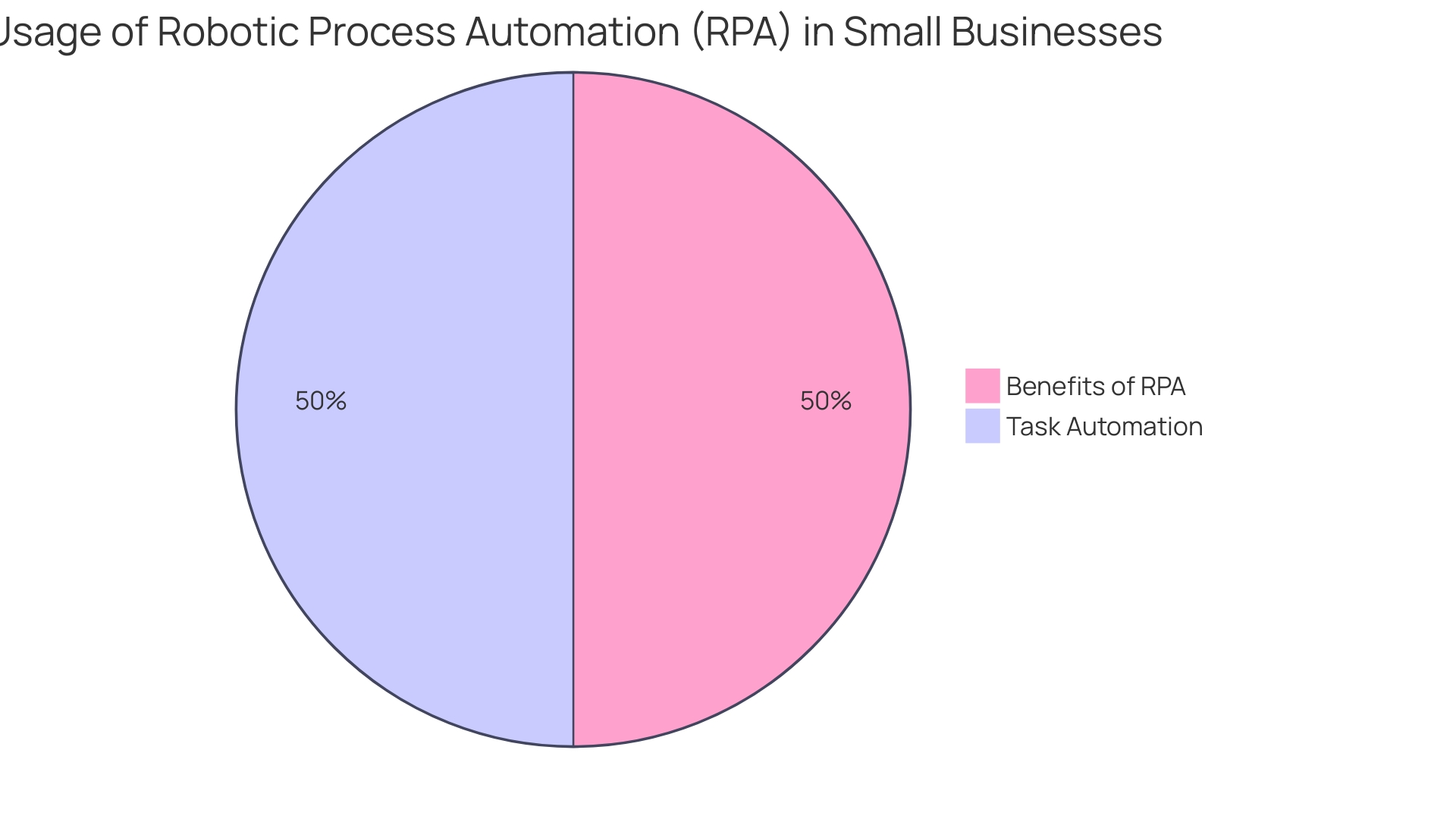
Cost Savings
Robotic Process Automation (RPA) serves as a transformative force in streamlining operations and elevating efficiency. RPA tools are adept at handling repetitive, rules-based tasks that once required manual effort, such as data entry and extraction, document processing, and routine customer inquiries. By deploying software bots to execute these tasks, enterprises like Millennium Recycling and St. James Winery have witnessed substantial improvements in productivity and a reduction in operational costs.
In fact, according to Allied Market Research, the burgeoning Robot Operating Systems Market is anticipated to soar from $534.2 million in 2022 to $1.8 billion by 2032, at a CAGR of 12.9%. This surge reflects the growing adoption of RPA and other technological advancements across various sectors, including the automotive industry, which now integrates between 1,000 to 3,500 semiconductor chips per vehicle to enhance reliability and safety.
Moreover, with the advent of RPA, companies gain the advantage of scaling their operations to match their growth trajectory. This is especially important for small enterprises that must uphold robust customer connections. RPA aids in this endeavor by accelerating response times and ensuring consistent and precise information delivery, fostering customer satisfaction and loyalty.
As RPA transforms the operational efficiency landscape, organizations are urged to carefully evaluate their procedures, identifying those ready for automation and the related time and cost consequences. This strategic approach paves the way to harnessing the full potential of RPA, culminating in both immediate and long-term rewards.
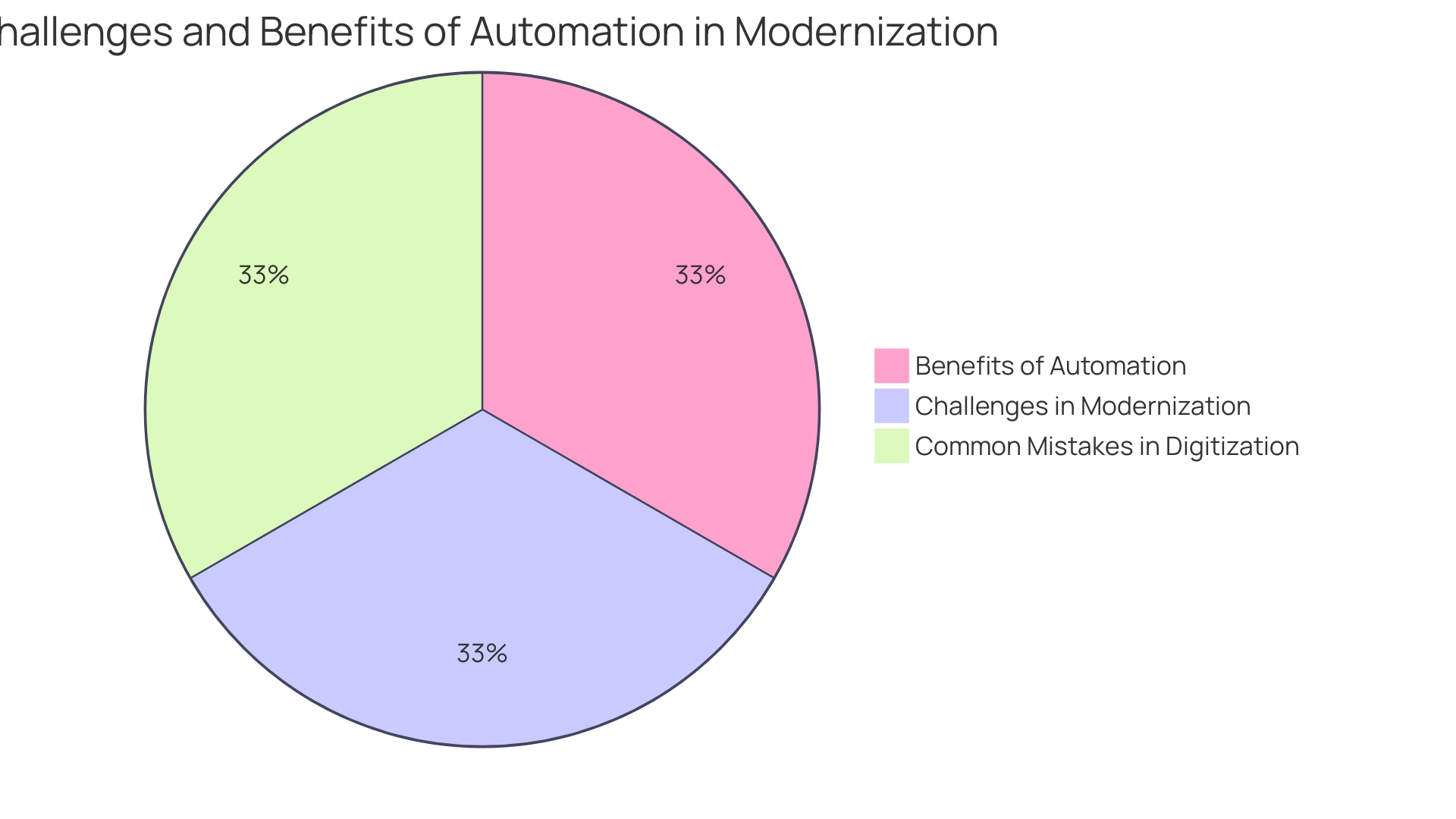
Improved Accuracy and Quality
Robotic Process Automation (RPA) is revolutionizing the way companies operate, ensuring precision and quality through its meticulous adherence to pre-set rules. This technological innovation is characterized by its ability to consistently perform tasks without deviations or errors. Companies like GrayMatter Robotics are at the forefront of integrating AI with robotics to elevate productivity and quality of life. For example, in manufacturing, the application of such advanced robotics has enabled businesses to achieve a higher standard of product finish, exemplifying the impact of RPA on process improvement.
In a rapidly changing market, Spanish firms have adopted mobile and social robot manufacturing, with a 45% increase in new companies specializing in technology for logistics, as reported in 2022. This reflects a broader trend of RPA adoption across industries. Moreover, with 65% of Spain’s robotics providers being integrators, there is a clear emphasis on customization and tailored automation solutions. This growth is not limited to the automotive sector, which currently utilizes half of Spain’s robots, indicating a vast potential for RPA to revolutionize other industries as well.
RPA’s influence on customer satisfaction cannot be overstated. For small enterprises, the accelerated response times and consistent accuracy offered by bots can greatly improve customer experiences, nurturing loyalty and satisfaction. As businesses scale, RPA becomes an invaluable tool for managing the increasing demands without sacrificing quality. By beginning with the mechanization of less intricate tasks and progressively expanding, companies can efficiently observe and record results, establishing a basis for more ambitious mechanization projects. Intelligent mechanization, via a combination of RPA and AI, is set to be a transformative force in the journey towards digital transformation, leading to more informed decisions and improved operational efficiency.
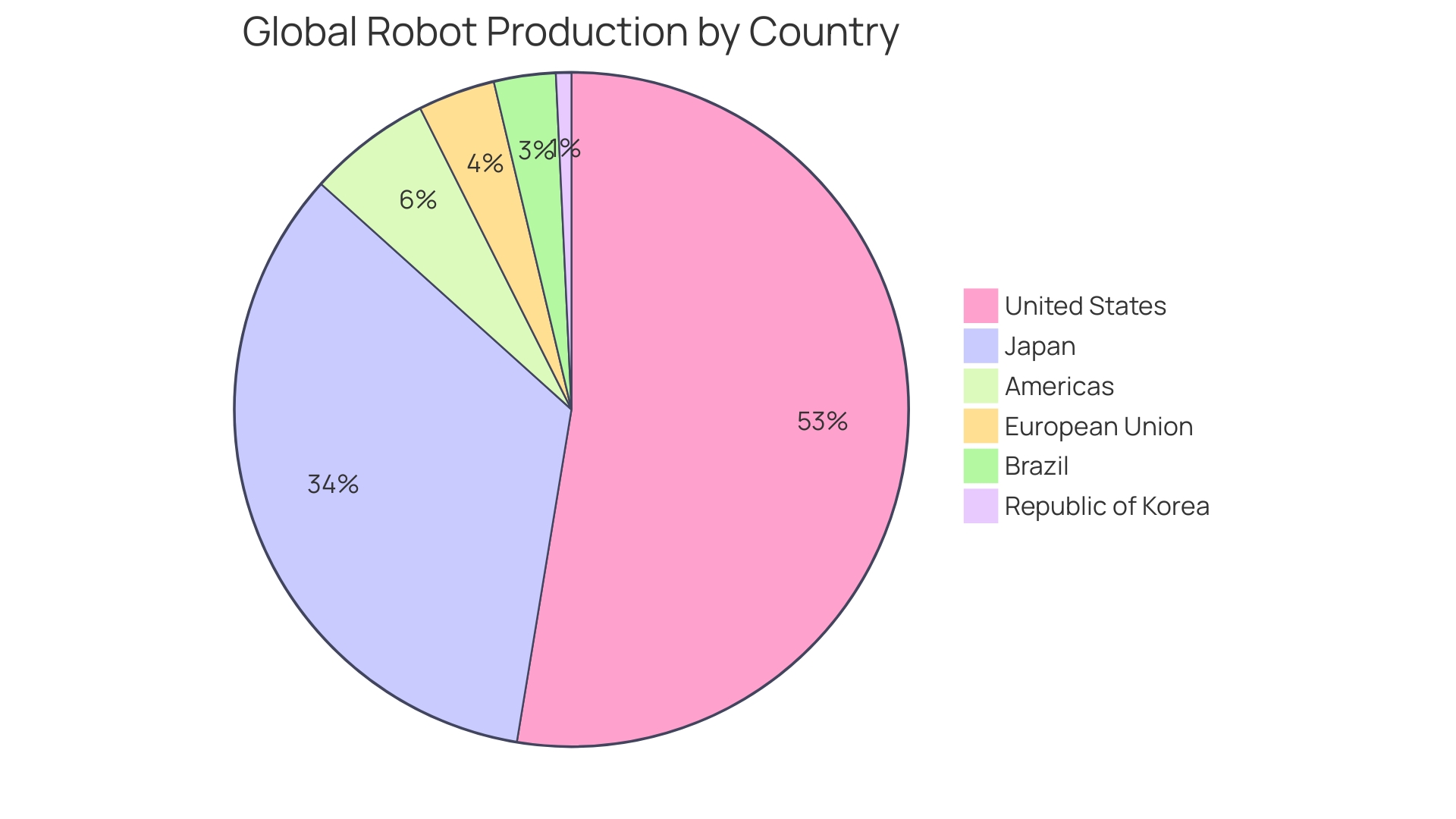
Enhanced Scalability
RPA technology stands as a pivotal tool for organizations aiming to thrive in a dynamic market by enhancing their scalability without incurring prohibitive costs. By implementing robotic tasks mechanization (RPA), companies can assign bots to handle spikes in work volume, thereby allowing businesses not only to grow but also to quickly adapt to changing market conditions. For example, Louvre Hotels Group, a significant player in the hospitality sector, utilized RobosizeME’s advanced technology to overhaul its rate code maintenance. The outcome? A remarkable monthly saving of 188 hours on rate code headers and 386 hours on rate code details, showcasing the profound impact of RPA on operational efficiency.
As we step into a future where technology trends are incessantly evolving, we observe an upsurge in the robot operating systems market, projected to reach $1.8 billion by 2032, growing at a CAGR of 12.9%. This growth not only underscores the escalating adoption of RPA across industries but also reflects the essential role it plays in sectors like automotive manufacturing, where semiconductors and robots are integral to producing more reliable and safe vehicles.
To guarantee a prosperous RPA implementation, it is crucial for decision-makers to carefully assess which manual processes are ready for mechanization and identify inefficiencies that RPA can resolve. Additionally, understanding the integration costs and potential ROI is crucial. By doing so, businesses can make strategic moves towards modernization, seizing opportunities for customer satisfaction improvements—as RPA expedites response times and ensures the accuracy of information—thus fostering customer loyalty.
To align with this, it is advisable to take a practical approach to the process of streamlining tasks, such as developing a comprehensive collection of tools for intelligent streamlining (IS) and commencing the streamlining process with less intricate tasks, gradually advancing to more complex workflows. Monitoring outcomes and documenting the lessons learned are essential for continuous improvement and future project scalability. Furthermore, the fusion of RPA and AI is recognized as a transformative force, empowering companies to refine processes and make more data-driven decisions.
The core of the upcoming work environment is not the exclusive dependence on mechanization but instead the harmonious coexistence of human and digital workforce. As one industry expert puts it, achieving a balanced partnership between automation and human ingenuity unlocks the workforce’s full potential, blending creativity, critical thinking, and emotional intelligence. In this situation, hyperautomation arises as a strategic requirement, urging organizations to consistently improve their procedures and embrace the future of work empowered by AI.
Observability in robotics, too, has become a vital concern. The shift from prototype robots to profitable fleets necessitates the integration of observability at each development stage, allowing for an in-depth understanding of robotic functions at scale.
In summary, RPA’s potential to revolutionize business operations is evident, with success stories and market growth projections attesting to its value. Leaders who are keen on leveraging RPA should do so with a clear strategy, informed decisions, and an eye on continuous enhancement, paving the way for a harmonious digital transformation.
Accelerated Process Execution
Robotic Process Automation (RPA) significantly improves execution by reducing bottlenecks and shortening cycle times. Unlike their human counterparts, bots are capable of executing tasks at a significantly swifter pace, contributing to a marked improvement in process efficiency. This leap in performance is evident in scenarios like Millennium Recycling’s adaptation of advanced technologies, which bolstered their operational efficiency, and Lindy’s deployment of AI assistants capable of integrating with a wide array of apps and services to proficiently handle diverse tasks.
Aligning with the insights shared in the 2023 Technology Trends eBook, RPA stands as a pivotal tool for small enterprises, fostering strong customer relations through rapid response times and consistent, accurate service delivery. Adopting mechanization can also aid enterprises in expanding operations seamlessly. As delineated by experts, RPA is adept at automating routine and manual tasks, adhering to predefined rules to execute these functions. Before adopting mechanization, companies should consider which manual operations are ready for mechanization, the inefficiencies that RPA can tackle, and the investment needed in terms of time and cost for integrating RPA solutions.
However, the journey towards automation is not without its challenges. For instance, a semiconductor foundry aiming to enhance R&D encountered hurdles like stakeholder resistance and inadequate change management. Yet, by pinpointing and targeting quantifiable goals and leveraging suitable tools, the foundry was able to standardize best practices and enhance project and technology management, thereby accelerating market readiness and reducing development costs. Such strategic implementation of RPA, focusing on high-value opportunities, can unlock considerable benefits and improvements for businesses venturing into digital transformation.
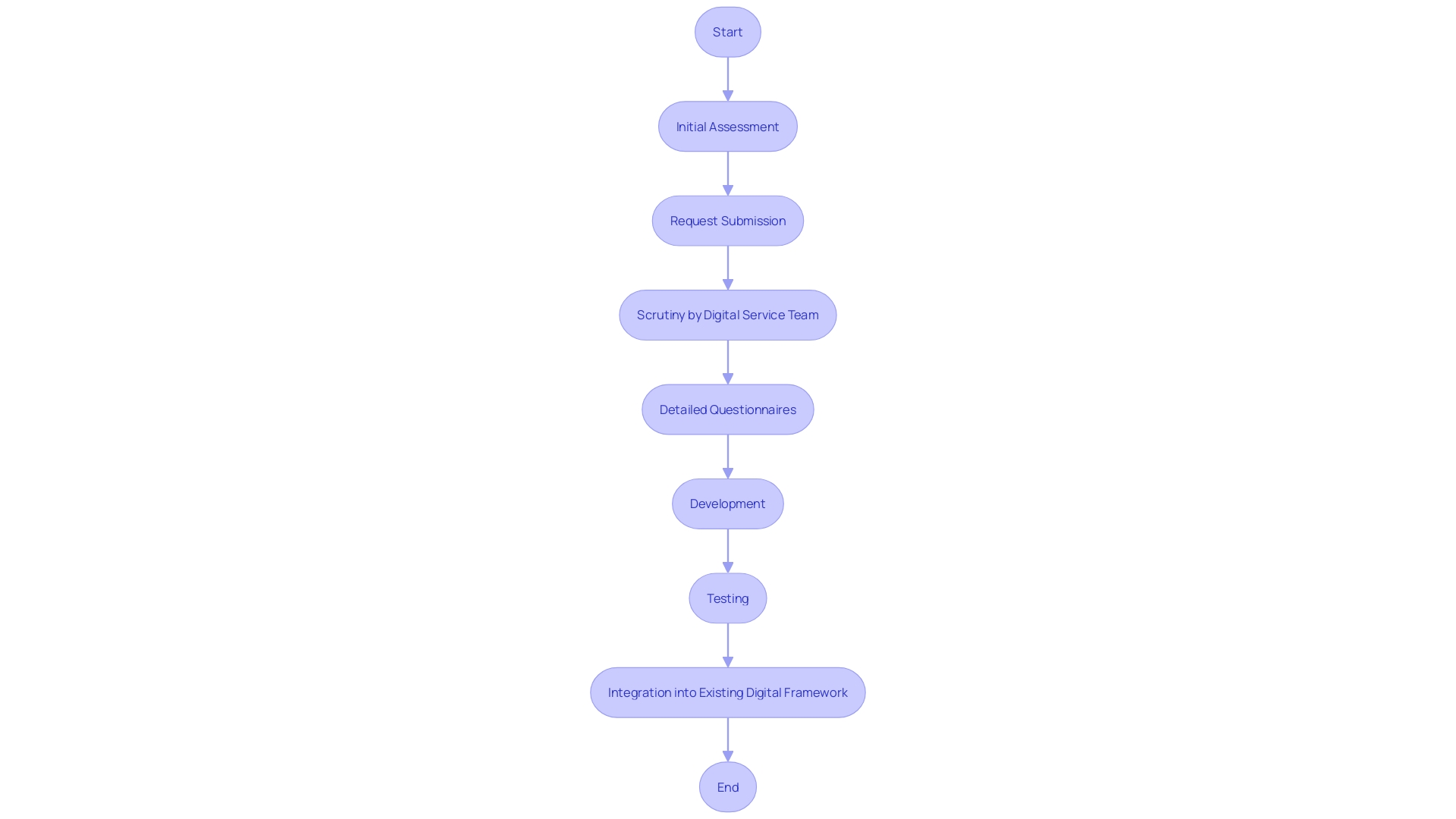
How to Get Started with RPA Robotics
Venturing into the realm of Robotic Process Automation (RPA) can revolutionize operational efficiency in any organization. The journey begins with a deep understanding of the process you wish to automate, identifying repetitive, rule-based tasks that a software ‘robot’ can handle with precision.
The foundation of a successful RPA initiative is selecting the right partner and solution. Take inspiration from industry leaders like Millennium Recycling, which has evolved into a pinnacle of operational efficiency through embracing advanced technologies. Similarly, GrayMatter Robotics exemplifies innovation by enhancing productivity with AI-driven robotics solutions.
When it comes to RPA applications, the Consumer Electronics Show (CES) showcases the latest breakthroughs, as experienced by Mike Oitzman. Boston Dynamics, for instance, continually pushes the envelope with robots like Atlas, which can perform tasks in complex environments.
The UiPath Citizen Developer Foundation offers a comprehensive learning plan for those looking to upskill in RPA. With 8 courses, including hands-on practices, it’s designed to introduce you to the process of creating automated processes across various industries.
For organizations considering Autonomous Mobile Robots (AMRs), it’s crucial to understand the shift from traditional capital equipment sales to a subscription-based model. This approach offers an informed pathway to choose the appropriate technological solutions without the responsibility of ownership and upkeep.
Automation, while enhancing efficiency and productivity, still requires an element of human collaboration for management and upgrades. The insights from the CTO of Reveille Software underscore the importance of human-AI partnership for stable operations.
From a systems perspective, building a robot is an interdisciplinary challenge that encompasses mechanical, electrical, and software engineering, to name a few. A keen understanding of the physics involved and the ability to simulate and test are key to developing efficient robotic systems.
In the ever-expanding Service Robotics market, both commercial and consumer sectors are experiencing significant growth. A robot’s autonomy and programmability are essential characteristics that drive its capability to perform a variety of tasks, from agriculture to logistics to medicine.
Finally, the incorporation of AI into RPA is gaining approval, as disclosed in a worldwide survey of professionals in the field of automated processes. Insights into the experiences and transitions of those in mechanization roles offer valuable information for hiring managers and CoE leaders looking to navigate the future of work.

Identify Suitable Processes
To fully harness the potential of Robotic Process Automation (RPA), it is vital to identify the suitable tasks for implementation. Look for tasks that are repetitive, rule-based, and involve high transaction volumes. Such processes are ripe for RPA, which can execute them with precision and efficiency.
GrayMatter Robotics exemplifies this approach by integrating AI with robotics to enhance human productivity and elevate the manufacturing industry’s quality of life. Their revolutionary work in the field highlights the importance of choosing appropriate tasks for mechanization. Similarly, RPA can significantly benefit small businesses by accelerating response times and ensuring consistent, accurate information delivery, bolstering customer satisfaction and loyalty.
As Reveille Software’s CTO and Co-Founder emphasizes, the act of automating tasks is not a set-it-and-forget-it solution. It requires continuous monitoring, management, and improvements. This historical viewpoint on mechanization shows that AI, while improving efficiency and productivity, still requires human oversight for optimal stability.
For companies embarking on digital transformation journeys, starting with manageable tasks and gradually advancing to more complex workflows can be a strategic move. A well-curated library of tools and regular documentation of outcomes are vital practices that pave the way for informed decisions and strategic planning.
Furthermore, a worldwide survey by UiPath, carried out between March and May 2023 with 1,639 professionals and students in the field of automated processes, emphasizes the changing encounters and beliefs regarding the use of automated systems in the work environment. This data emphasizes the significance of comprehending the subtleties of RPA integration and its effect on operational procedures.
In conclusion, RPA is a powerful tool for enhancing operational efficiency. By strategically selecting processes for automation and maintaining a partnership between enterprises and technology, companies can optimize productivity and foster long-term growth.
Evaluate RPA Tools and Platforms
Choosing the appropriate Robotic Process Automation (RPA) tools and platforms is a crucial stage for enterprises aiming to optimize their operations. An essential consideration is the ease of use, which ensures that the workforce can adopt the technology with minimal disruptions. Scalability is another crucial element, as it determines whether the RPA solution can expand alongside the organization, accommodating increased workloads without performance loss.
Integration capabilities are vital to ensure the RPA software works seamlessly with existing systems and applications. This reduces the complexity and potential costs associated with integrating new technology into current infrastructures. Vendor support is also crucial, as it provides businesses with the assistance needed to troubleshoot issues, access updates, and navigate the evolving landscape of technology.
Case studies, like that of Lindy, an AI assistant platform, highlight the importance of comprehensive integration capabilities. Lindy’s challenge of developing a vast network of app integrations underlines the significance of choosing RPA platforms that can easily connect with a wide range of services and applications, thereby shortening development time and accelerating market entry.
Recent developments in AI usage across industries, as seen in UK public transport and the TSA’s facial recognition program, underscore the importance of ethical considerations and privacy rights when implementing new technologies. Businesses must carefully evaluate RPA tools to ensure they comply with regulations and ethical standards, particularly when handling sensitive data.
Data shows a increasing pattern among professionals and students in incorporating AI into their working activities. Based on a worldwide study carried out by UiPath, involving 1,639 respondents, findings on AI expose its potential influence on operational efficiency and the simplicity of shifting to automated positions.
In summary, when assessing various RPA tools and platforms, organizations should prioritize ease of use, scalability, integration capabilities, and vendor support, while also taking into account ethical considerations and the ability to meet future technological demands. This strategy guarantees a strategic investment in mechanization that aligns with both present operational requirements and long-term objectives.
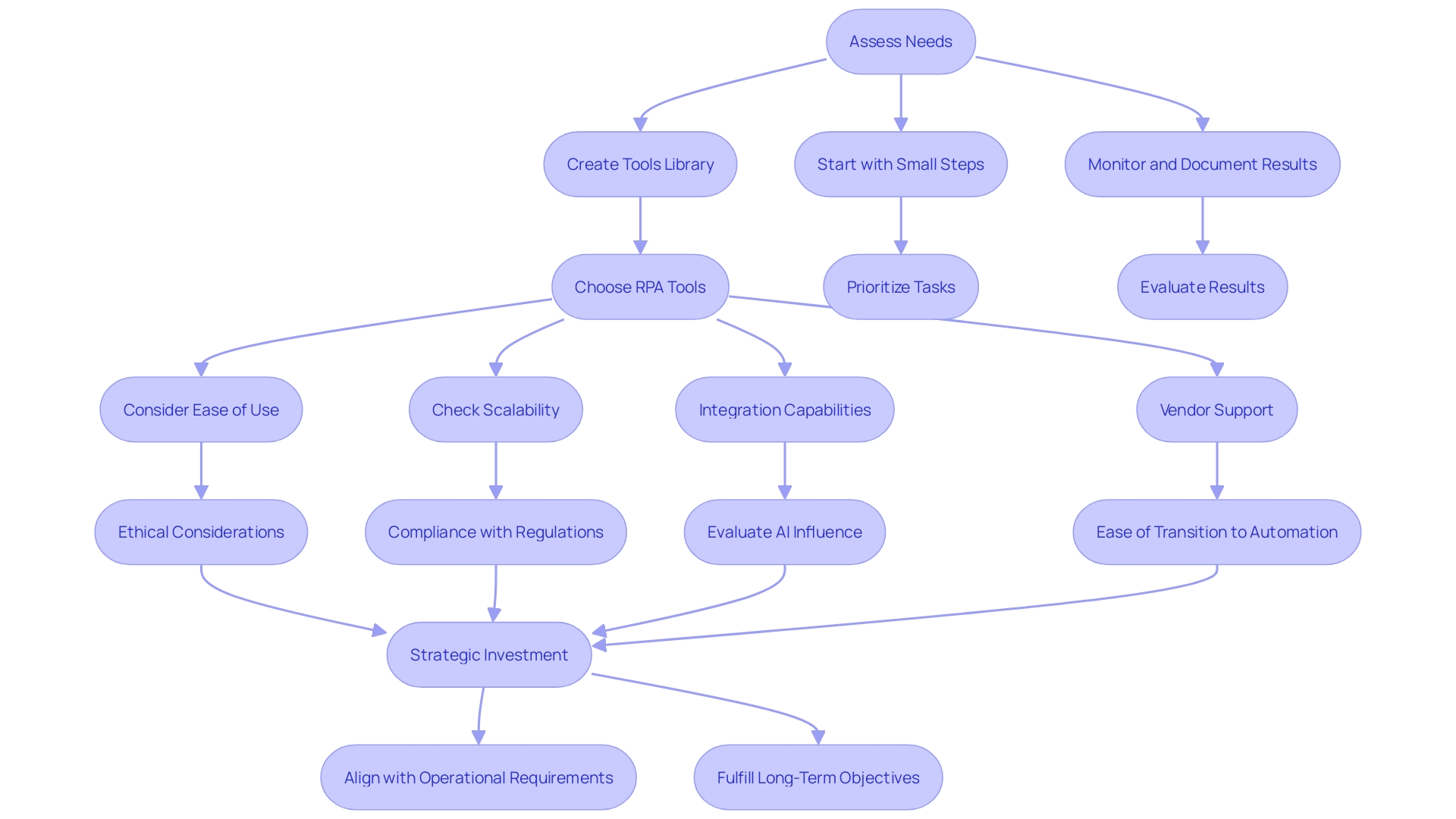
Design RPA Solution
Creating a thorough RPA solution demands a careful method where both business and IT teams collaborate to build a seamless strategy. This necessitates a comprehensive analysis of the flow of operations to identify potential opportunities for robotic process streamlining, followed by establishing the guidelines and logic that the RPA bots will adhere to.
For instance, consider the approach taken by a healthcare trust to enhance their digital services. When a department seeks to implement new digital technology, a request form is initiated and reviewed by the Digital Service Team. They conduct an initial assessment to ensure that the requested technology is secure, appropriate, and in compliance with existing standards. This procedure also involves confirming whether the trust already has comparable technology or functionality, thus preventing duplication and guaranteeing efficient utilization of resources.
Similarly, Rivian, an electric vehicle company, has set ambitious environmental targets, including achieving net zero emissions by 2040. To support this objective, Rivian aims to enhance its worldwide operations, which entails identifying processes that can be accelerated and made more sustainable. This could include streamlining their supply chain, minimizing waste, or improving manufacturing workflows with RPA solutions.
Furthermore, the recent introduction of checkout-free stores, such as the one in Dublin Airport, showcases the game-changing potential of technology in retail. By incorporating cutting-edge technologies such as camera systems and weight-sensored shelving, customers undergo a seamless shopping experience, emphasizing the significant advantages that advanced processes can offer to different sectors.
Prior to starting the RPA adventure, leaders need to tackle important inquiries like which manual tasks are ready for automation and where inefficiencies exist that can be resolved through RPA. The integration of RPA must be justified by a clear understanding of the time and cost savings it will bring to each identified process.
With the global economy transitioning towards a digital-centric approach, companies are increasingly acknowledging the vital role of big data and analytics in decision-making. The rise of big data analytics as a revolutionary technology highlights the necessity for enterprises to adjust and incorporate these tools to maintain expansion and stay competitive in an unpredictable market.
In this transformative era, the collaboration between design and engineering is paramount. As quoted, ‘Creating digital experiences that make sense for humans depends heavily on the work of both designers and engineers.’ The synergy between these fields is a driving force behind the successful deployment of RPA solutions that are user-friendly and efficient.
The impact of investing in intelligent automation is evident, with studies demonstrating significant revenue growth and compound annual growth rates for enterprises that have utilized these technologies. These findings underscore the potential of RPA to contribute to the overall net present value (NPV) and long-term business success.
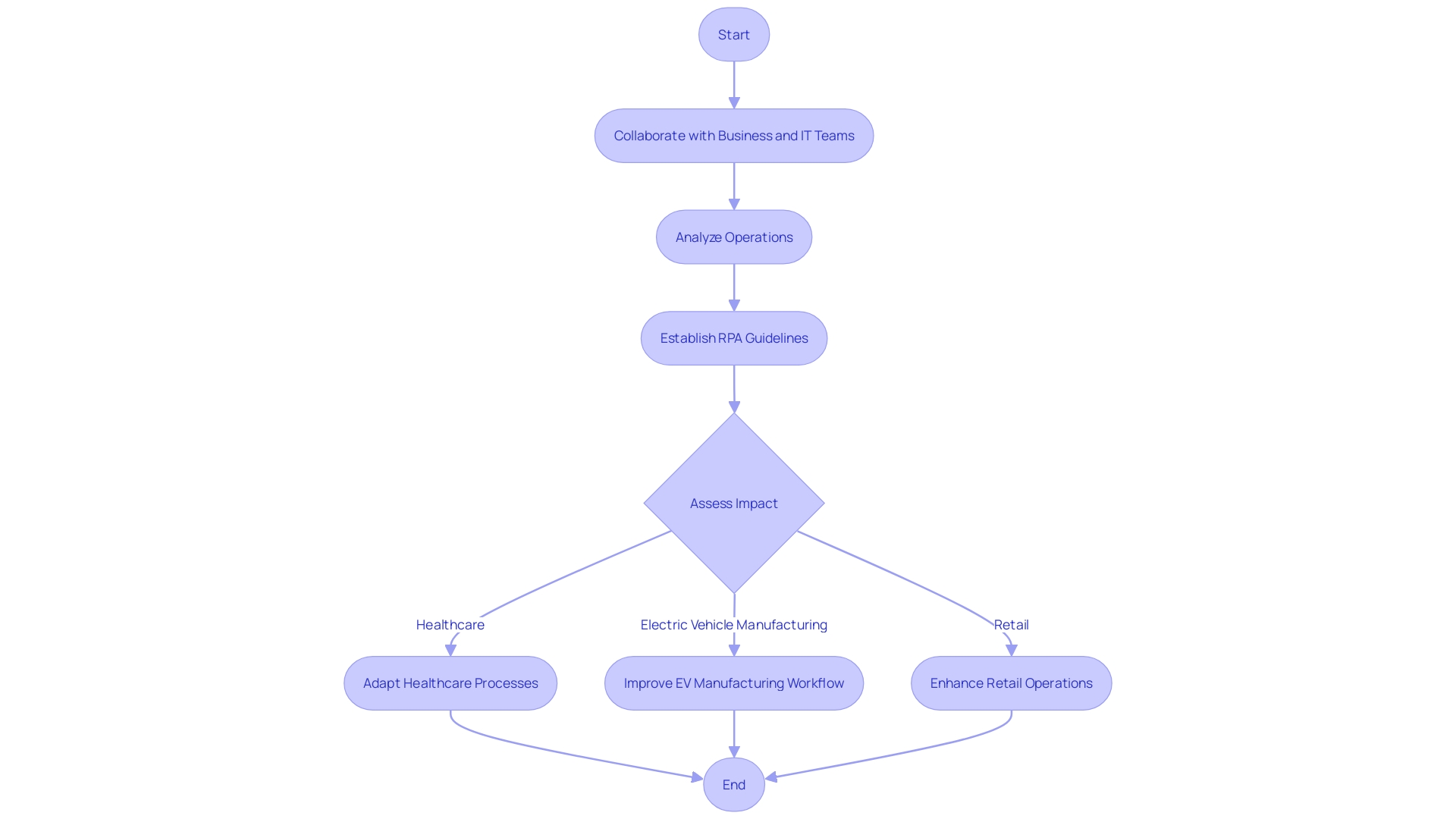
Develop and Test Bots
When it comes to developing and fine-tuning the sophisticated bots that are essential in today’s digital landscape, it’s a multifaceted endeavor that goes beyond mere configuration. It’s akin to the procedure that a Digital Service Team within a healthcare setting would employ when introducing new technology: rigorous assessment to ensure security, appropriateness, and compliance. Just as they would meticulously evaluate a technology request via questionnaires to determine if a similar solution already exists or if it aligns with the organization’s needs, developing bots also involves a detailed and exacting testing phase.
Acceptance testing, a critical step in the bot development lifecycle, mirrors this thoroughness. It’s where bots are scrutinized to confirm they meet predefined requirements and perform reliably in real-world scenarios. This phase, imperative especially in sensitive industries like healthcare and finance, is the safeguard against legal and compliance pitfalls.
Moreover, the bots undergo a self-calibration routine, as exemplified by Tesla’s Optimus robot, enabling them to adapt to new environments and interact with precision. The integration of vision and joint position sensors allows these bots to perform tasks with human-like dexterity, showcased by Optimus’ ability to sort objects even amidst environmental changes.
The procedure is backed by a organized approach, starting from defining the scope and choosing the appropriate tools to setting up the environment and preparing test data, guaranteeing that the bots are not only functional but also efficient and effective. Given the constantly changing AI landscape, as emphasized by the UiPath Community’s yearly report, it’s evident that professionals in this domain consistently adjust to incorporate and leverage new advancements like generative AI and large learning models.
In essence, the journey from bot conception to deployment is a meticulous blend of planning, preparation, and rigorous testing that ensures these digital workers are ready to perform their tasks reliably and in compliance with all necessary standards.
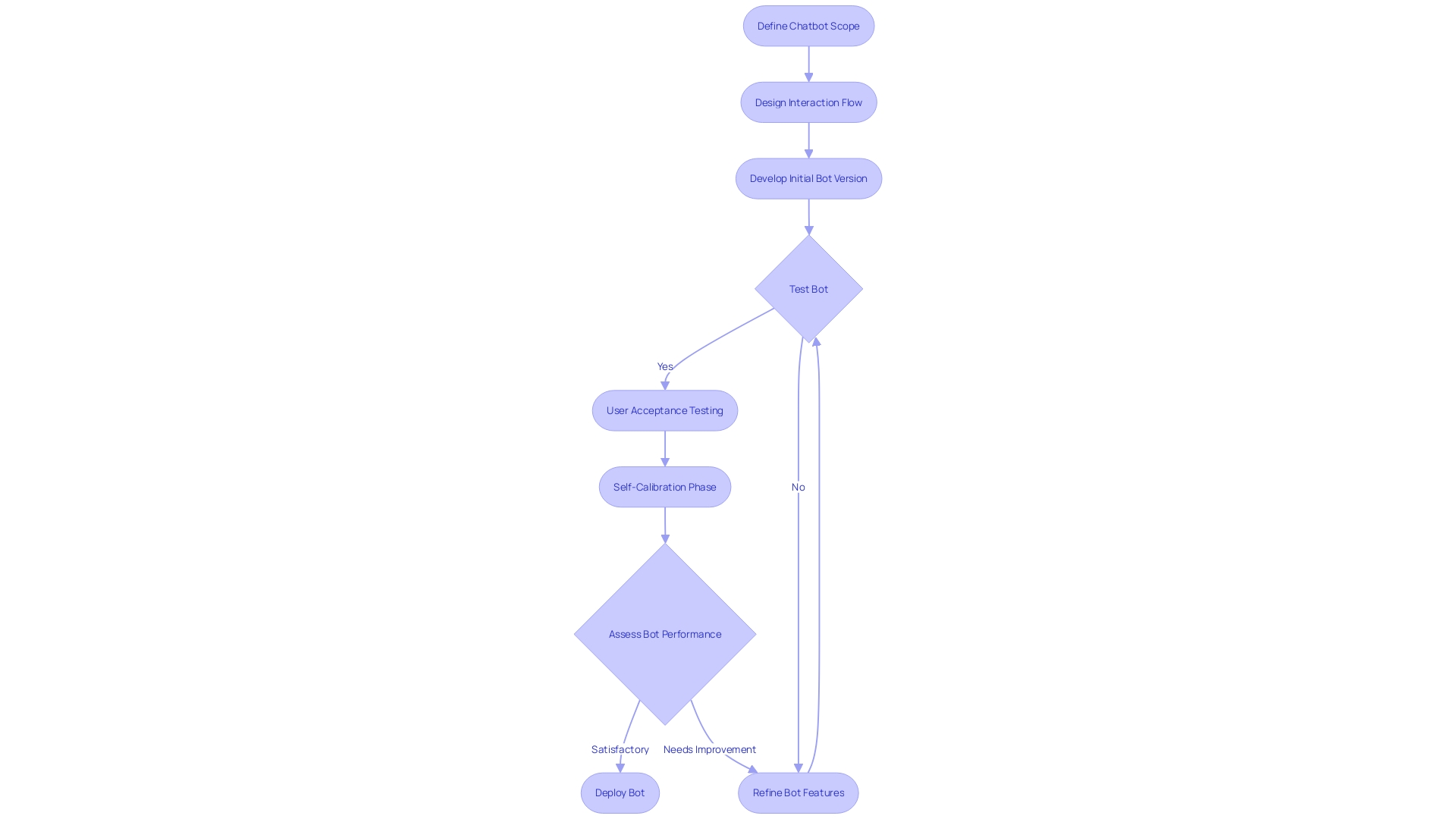
Deploy and Monitor Bots
Incorporating robotic task mechanization (RTM) into day-to-day tasks necessitates more than simply configuring it and withdrawing. It’s a continuous cycle of evaluation and refinement. Consider, as an instance, the careful digital-assurance used by healthcare trusts to assess new technologies. Before deployment, a comprehensive initial assessment is conducted to ensure the technology’s security and appropriateness, followed by detailed questionnaires to understand the requester’s needs and justification for the technology. Similarly, RPA bots must be deployed thoughtfully, with a keen eye on their performance to identify any operational issues promptly. By consistently analyzing bot activities and making necessary adjustments, companies can uphold the high standards of efficiency and productivity anticipated from such advanced mechanization solutions. This approach aligns with industry best practices, where software life cycles are adapted to the unique nature of AI and RPA, ensuring that these systems remain functional, reliable, and secure over time.

Key Components of RPA Robotics
Robotic Process Automation (RPA) is an amalgamation of advanced elements, each vital for streamlining and automating complex business processes. At the core of RPA’s transformative power lies its ability to integrate with various systems and manage tasks that traditionally required manual input.
Particularly noteworthy is the emerging trend of Autonomous Mobile Robots (AMR) in the marketplace. These robots are transforming industries by providing adaptable and expandable solutions for operational challenges. A study by Interact Analysis from their 2024 Mobile Robots Buyer Survey highlights the growing acceptance of mobile technology. The survey, which gathered insights from 300 buyers across different sectors, revealed a growing preference for mobile robots due to their versatility and efficiency.
Companies like GrayMatter Robotics are leading the charge in enhancing human productivity with AI-driven robotics. This approach is reshaping manufacturing, ensuring that products meet the desired quality standards through advanced robotic solutions. The success of such technologies is evident in the projected growth of the robotics market, with Allied Market Research forecasting a significant rise to $1.8 billion by 2032 at a CAGR of 12.9%.
The incorporation of semiconductors in the automotive sector illustrates the need for accurate and dependable mechanization. Modern vehicles may contain anywhere from 1,000 to 3,500 semiconductor chips, indicating the extent of technology’s reach into our daily lives. Furthermore, the adoption of mobile robots for inventory control by hardware retailers showcases the practical applications of RPA across various sectors.
The future of RPA is not just about the technology itself but also how it’s delivered to organizations. The idea of Robotics as a Service (RaaS) is transforming the conventional capital equipment sales model, offering a subscription-based pricing and service delivery that has the potential to revolutionize the way enterprises approach mechanization investments.
As the field of corporate mechanization advances, the significance of strategic alliances with visionary technology providers becomes more evident. These partnerships are essential for navigating the rapid evolution of the tech industry and for ensuring that companies remain at the forefront of innovation and efficiency.
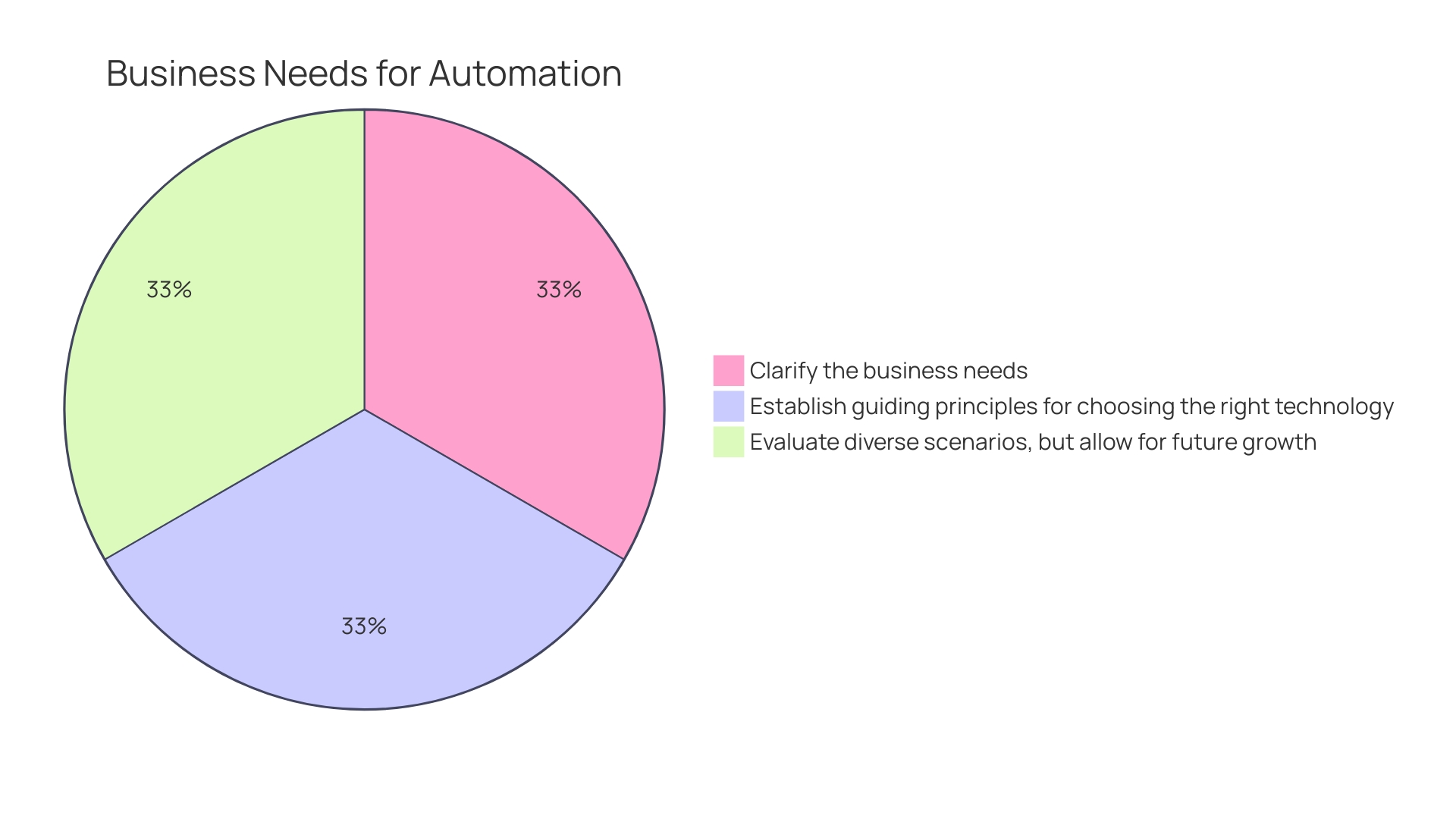
Bot Development Studio
The modern Bot Development Studio goes beyond a simple environment for creating bots; it’s a crucible of innovation where developers bring bots to life, imbuing them with advanced capabilities such as generative AI. These studios equip developers with a comprehensive suite of tools that enable the crafting of sophisticated automation workflows, the articulation of intricate business rules, and seamless integration with a plethora of systems. The advent of AI-powered features within these studios has been pivotal in enhancing the functionality and intelligence of bots, propelling them to new heights of efficiency and relevance across a diverse range of industries including messengers, commerce, education, and healthcare. The intuitive interface of these studios allows for the creation of bots that are not only adept at responding to user queries and executing tasks but are also capable of understanding and interacting in multiple languages, thereby bridging communication gaps and fostering inclusivity. These advancements have been demonstrated through real-world applications, such as a chat application showcased in November 2023 that leveraged the latest AI technology to deliver a transformative user experience. The fundamental strength of these studios is their capacity to democratize the development procedure, making bot creation accessible to those with different levels of technical expertise. This democratization is critical in a rapidly evolving digital landscape where timely adaptation and integration of cutting-edge technologies are imperative for staying competitive and meeting the ever-growing demands of users.
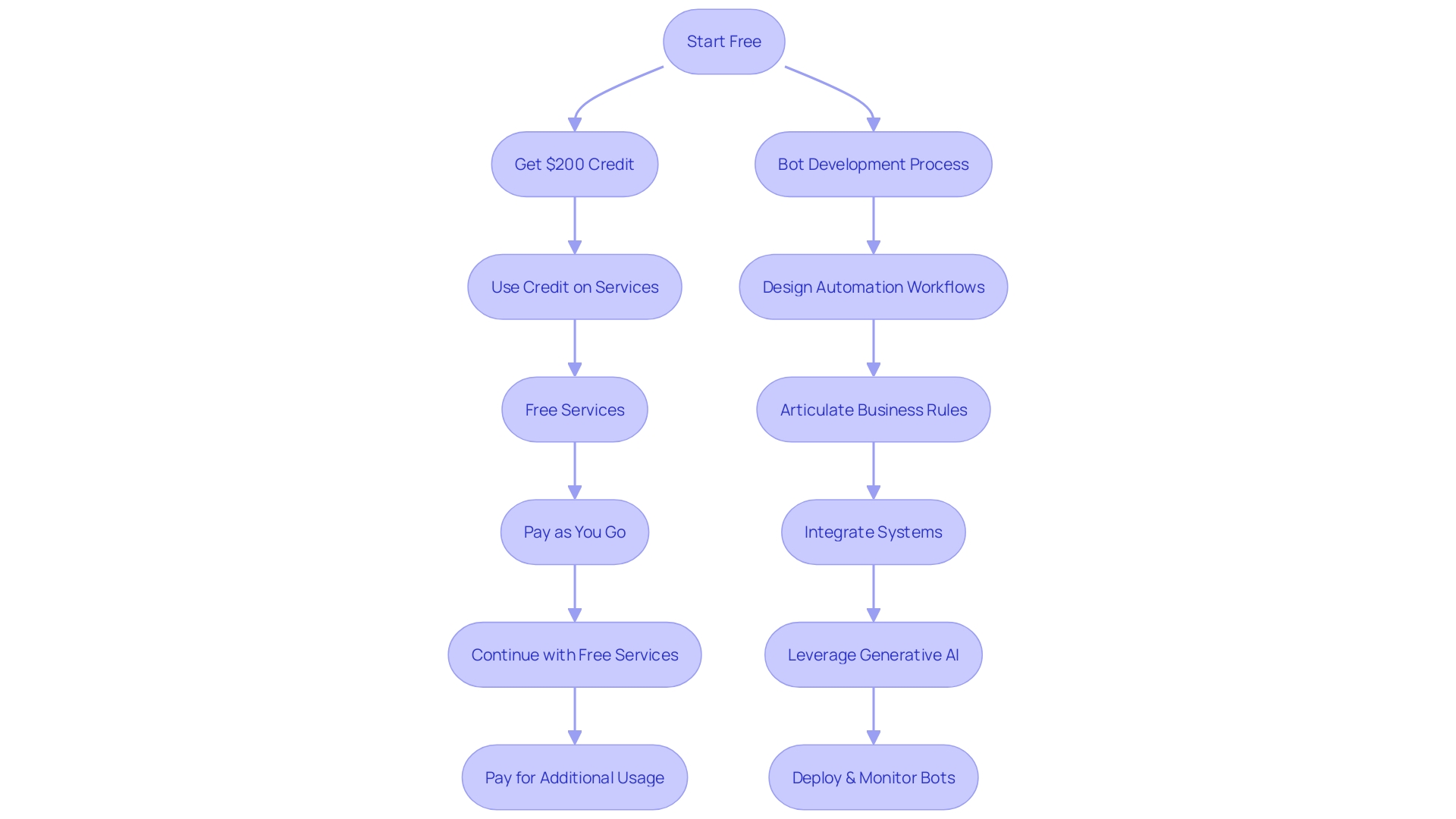
Control Room
The Control Room in Robotic Process Automation (RPA) serves as the command center for managing the fleet of bots at your disposal. It’s designed to offer a comprehensive overview of bot activities, akin to a flight control dashboard that keeps track of all the airborne planes. With the ability to monitor bot performance in real-time, the Control Room facilitates the scheduling of tasks, ensuring high-priority jobs are completed promptly while dynamically reassigning resources to maintain optimal workflow.
To demonstrate the capabilities of the Control Room, consider how a wall time analysis can offer insights into efficiencies by examining stack traces from running operations. This level of scrutiny enables the detection of bottlenecks and inefficiencies, much like how Discord, a widely-used communication platform, manages its massive user traffic. By analyzing and understanding system performance, opportunities for enhancement in both throughput and responsiveness become evident.
The mobile robotics industry, booming with a valuation of approximately $20.3 billion, expects a doubling by 2028. Companies like igus are democratizing access to mobile robotics by offering affordable plastic robots. This underscores the importance of cost-effective solutions in operational technology, similar to how the Control Room enables more efficient bot management without incurring exorbitant costs.
Moreover, the Control Room aligns with the philosophy that automation, while a path to improved efficiency and productivity, is not a set-and-forget solution. It requires continuous monitoring, management, and upgrades, as noted by the CTO and Co-Founder of Reveille Software. These improvements and administrative approaches are crucial to guarantee the stability of automated operations, including those driven by AI.
Finally, the integration of RPA into business processes has been shown to significantly increase productivity. Findings from Microsoft’s “AI and Productivity” initiative reveal that tools like Copilot, powered by Large Language Models (LLMs), not only accelerate task completion but also maintain quality. This is a testament to the value offered by mechanization tools, further emphasizing the role of the Control Room in overseeing and enhancing the performance of RPA bots.
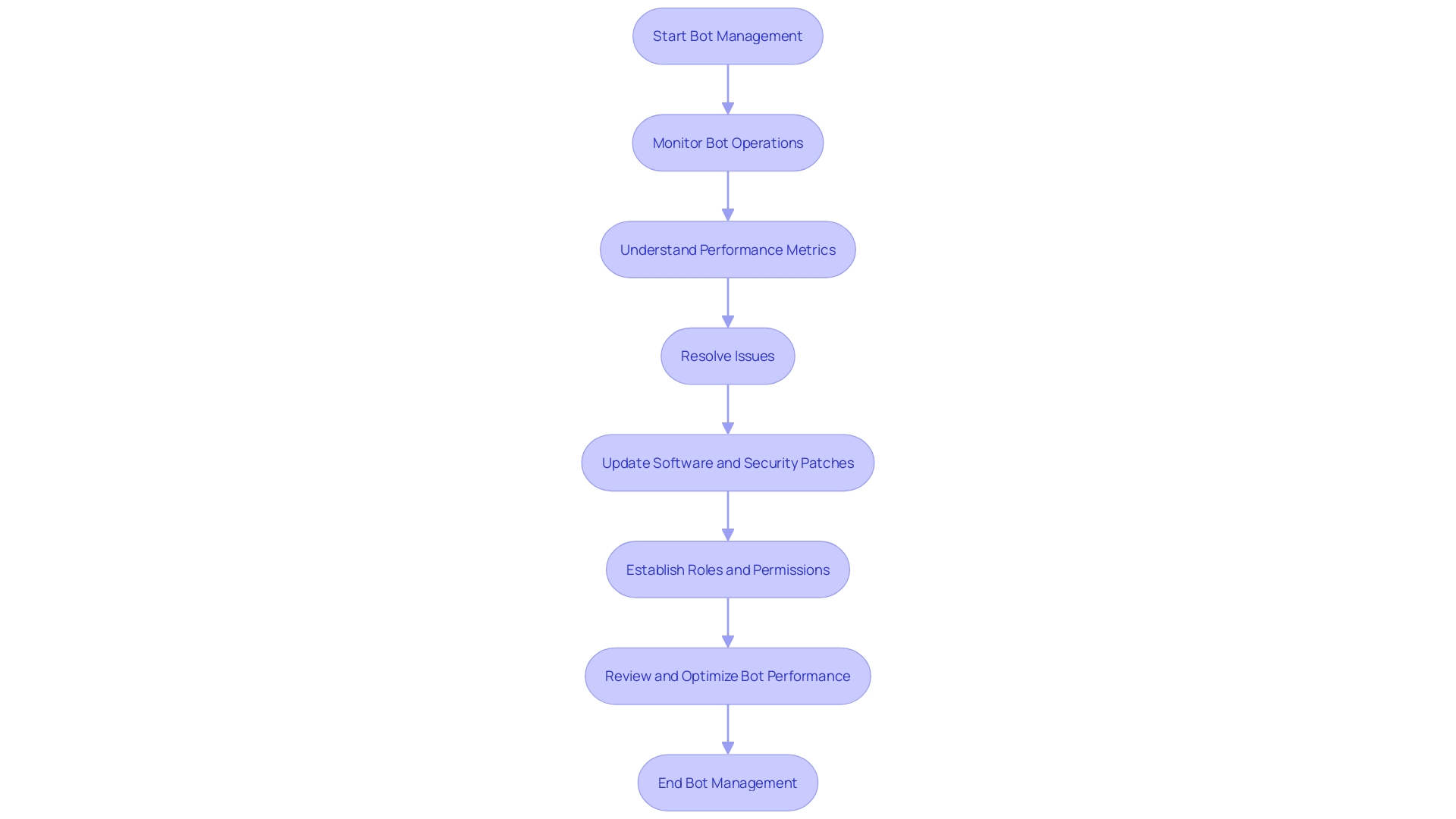
Bot Orchestrator
In the dynamic realm of artificial intelligence, the Bot Orchestrator emerges as a pivotal figure, akin to a conductor in an orchestra, ensuring each bot performs its part in harmony with the larger automation symphony. Tasked with the crucial responsibility of managing the bot workforce, the Orchestrator delegates assignments, keeps a vigilant eye on operational flow, and upholds the seamless execution of automated processes.
This role is exemplified by the innovative practices in companies like Specsavers, where the orchestration of AI extends to enhancing customer experiences and addressing the unique challenges of the optometry industry. Similarly, Lindy’s AI assistant showcases the breadth of tasks that can be automated, from medical scribing to executive assistance, all relying on the effective coordination of a vast network of applications and services.
As AI continues to revolutionize industries, the significance of the Bot Orchestrator cannot be overstated. According to recent insights, orchestration is deemed an indispensable tool for the deployment of AI applications, serving as the bridge between a concept’s inception and its consistent, real-world functionality. It’s the Bot Orchestrator’s domain to guide ideas through the metaphorical gates of ‘Once’—a single successful prototype demonstration—and ‘Mostly’—the consistent performance necessary for launch readiness.
Statistics underscore the importance of dynamic adaptation in AI systems, much like the ELO rating in chess, which evolves with each game to reflect a player’s current performance. In this context, the Bot Orchestrator ensures that the automated systems are not only functioning but also continuously improving.
The rapid growth of AI applications and their real-world evaluations, as seen in the Chatbot Arena, further reinforces the need for Bot Orchestrators. With over 45 models deployed and more than 130,000 user votes collected, the role of orchestrating these entities to cater to a myriad of use cases becomes increasingly complex and vital.
In this ever-evolving technological landscape, the Bot Orchestrator stands as a cornerstone, ensuring that AI systems are not only effective and ethical but also finely tuned to the changing rhythms of industry demands and user preferences.
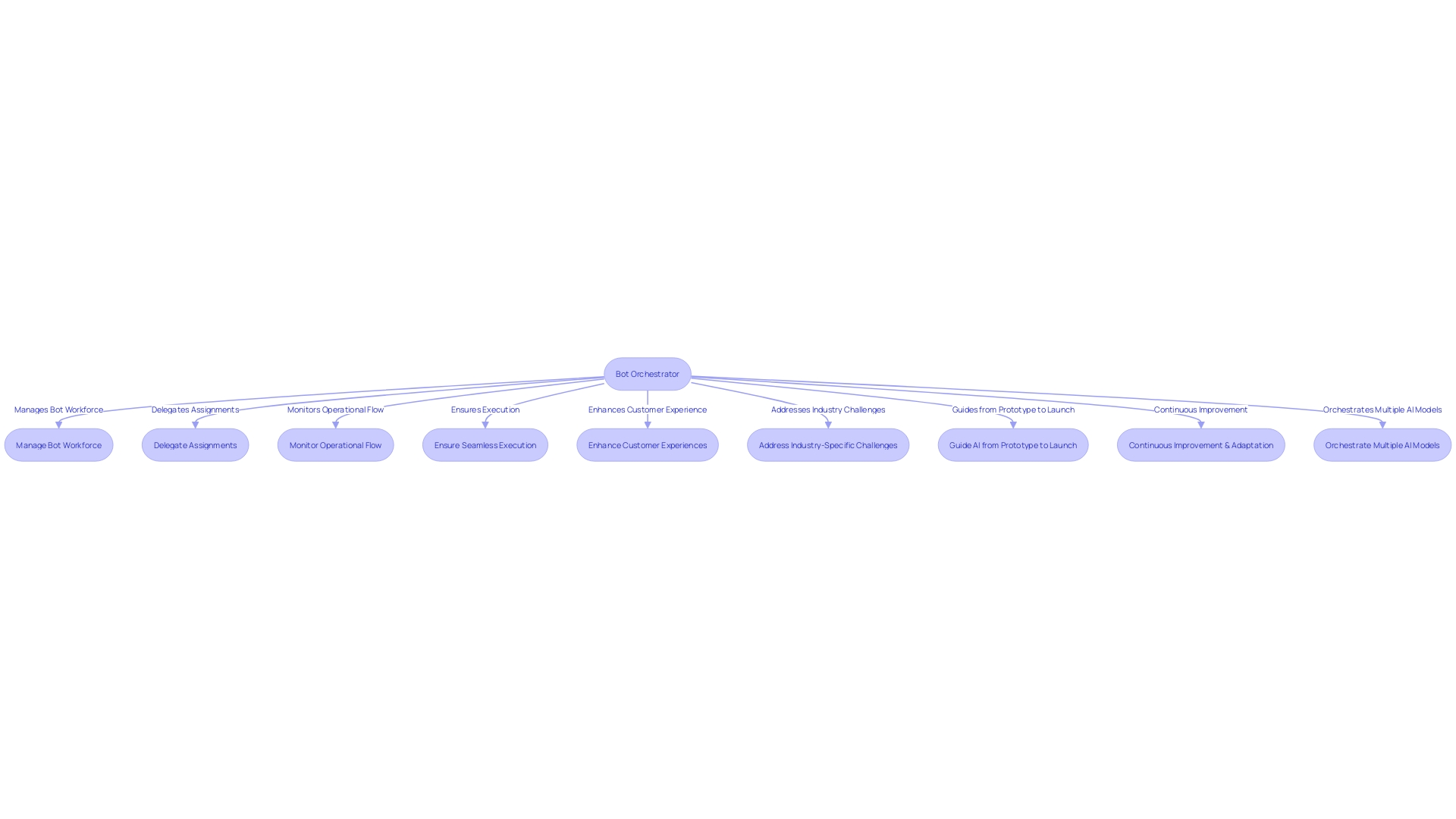
RPA Tools and Platforms
With a myriad of Robotic Process Automation (RPA) tools available, selecting the right platform can be a strategic decision for any business. Power Automate and UiPath are prominent in the market, with a collective dominance of approximately 70% in the global sphere of automated processes. Power Automate provides ready-made templates for common situations, streamlining the process of carrying out repetitive tasks. Meanwhile, UiPath is celebrated for its extensive user base, boasting 2260 reviews with an average rating of 4.5, highlighting its widespread approval and effectiveness.
The significance of RPA goes beyond mere task performance; it serves as a transformative force in operational efficiency. A global survey of 1,639 professionals specializing in mechanization conducted between March and May 2023 sheds light on the current trends and acceptance of RPA. The findings emphasize the smooth transition automation professionals experience in the workplace and the growing interest in integrating AI into their roles.
Furthermore, while enterprises navigate the complex terrain of RPA, the implementation procedure reflects the methodical approach observed in the healthcare sector. For instance, the NHS employs a thorough digital assurance process for new technology adoption, ensuring security and compliance. This methodical approach to embracing digital solutions is reflective of the careful consideration businesses must undertake when integrating RPA platforms into their operations.
In the realm of public services and defense, AI and mechanization are progressively shaping strategies. For example, trials in the UK’s public transport system indicate that AI can enhance safety and efficiency. However, ethical concerns, particularly regarding privacy, cannot be ignored. These examples serve as a reminder that while mechanization is a powerful tool for innovation, it requires a balance between technological advancement and ethical considerations.
The process towards mechanization is not a solitary one. As mentioned by the CTO and Co-Founder of Reveille Software, the evolution of mechanization has progressed throughout history, from the water wheel to AI, and it still necessitates human supervision. In this changing time, collaborations with technologically innovative organizations, like Coding Crafts, can offer a complete range of services, including blockchain development, adding an extra level of security to digital procedures.
For businesses looking to utilize RPA, the incorporation of such technologies is not only about efficiency but also about preparing for a future where mechanization and human expertise merge to form a more dynamic and productive work environment.
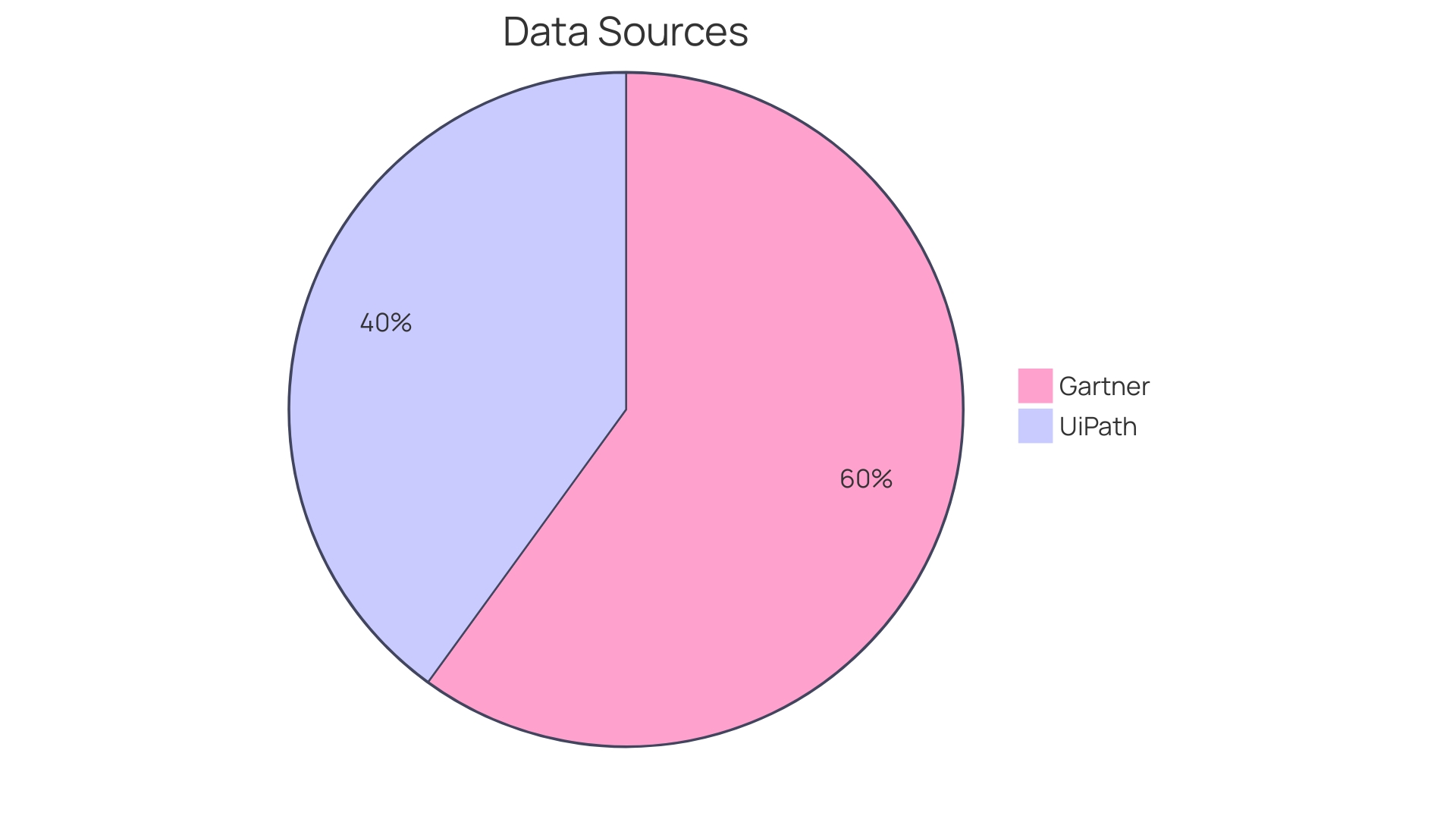
UiPath
UiPath stands at the forefront of Robotic Process Automation (RPA) technology, not only providing a robust platform for the design, deployment, and management of bots but also integrating artificial intelligence (AI) to enhance its capabilities. The platform is celebrated for its user-friendly drag-and-drop interface that simplifies the creation of automated workflows. It is particularly adept at executing repetitive tasks, such as data entry and report generation, liberating employees from monotonous work and allowing them to focus on more complex and creative tasks.
In the real world, companies like Hiscox, a specialist insurance firm, have harnessed UiPath to significantly decrease their email response times by 28%, directly impacting customer satisfaction and operational efficiency. This strategic move has enabled Hiscox to cope with rising demands without proportionally increasing operational expenses, a testimony to the platform’s promise of sustainable growth.
UiPath’s AI functions extend to communications mining, which can analyze both internal and external communications to automatically fill in data. This feature becomes an invaluable asset for companies aiming to streamline their processes and enhance the personalized touch in customer interactions.
Moreover, the platform’s growing popularity is reflected in the dramatic expansion of the RPA market, which was valued at $2.9 billion in 2023 and is expected to swell at an annual growth rate of 39.9% through 2030. UiPath, as a pioneering force in this industry, is poised for significant market gains if it maintains its growth trajectory alongside the industry’s overall expansion.
The platform is also a touchstone for professionals and students in the field, with a community of 1,639 members surveyed recently expressing their experiences and readiness to integrate AI into their roles. UiPath’s community initiatives, such as events and hackathons, are avenues for these professionals to engage with the technology, further solidifying the platform’s position as a cornerstone in the RPA landscape.
Automation Anywhere
As a leader in the RPA domain, Automation Anywhere stands out with its intuitive user interface and powerful automation tools. The platform is equipped with advanced features such as intelligent recorders, AI-powered bots, and a flexible architecture designed to scale with organizational requirements. It enables organizations to effectively automate complex workflows, which is pivotal in today’s fast-paced professional environment.
Workflow automation is a critical technology that organizations use to automate complex processes, which helps reduce manual efforts and minimize human errors. By utilizing software applications, algorithms, and predefined rules, Automation Anywhere aids in automating repetitive tasks, enhancing communication, and efficiently managing the workflow.
According to a report from Zapier, nearly all employees in small businesses engage with repetitive tasks such as sending notifications or managing permissions. Automation Anywhere’s technology can transform how these tasks are handled, thereby enhancing employees’ work experiences.
The importance of workflow streamlining is evident in the achievements of companies like Pegasystems, which has experienced significant revenue growth because of the growing need for contemporary software. This demand is driven by the need for more intricate process mechanization across various industries.
Moreover, recent global surveys, including one conducted by UiPath with 1,639 AI professionals and students, emphasize the increasing acceptance of AI and mechanization in the workplace. The findings underscore the importance of platforms like Automation Anywhere in supporting professionals during their mechanization journeys and the integration of artificial intelligence into their daily tasks.
Automation Anywhere not only simplifies the mechanization of routine tasks but also empowers organizations to harness the power of AI, making it a crucial tool for any business looking to stay competitive and agile in the evolving market landscape.
Blue Prism
Blue Prism is recognized for being a robust RPA tool, providing a variety of functionalities like a designer, control room, and a digital workforce manager. These features are designed to cater to complex, enterprise-level needs for advanced processes. Leveraging RPA, companies like Lindy can integrate a vast network of applications and services, empowering AI assistants to perform an extensive variety of tasks efficiently. This is particularly crucial when faced with the challenge of developing numerous integrations that could otherwise take a significant amount of time and delay market entry.
For instance, Delivery Hero utilized RPA to streamline the account recovery process, which was a recurring issue for its extensive workforce of over 53,000 employees globally. By automating the resolution of approximately 800 monthly account lockouts, which previously took an average of 35 minutes each, the company significantly reduced downtime and enhanced productivity.
Furthermore, Hiscox, a specialist insurance company, successfully employed technology to handle the high volume of client emails. By reducing the repetitive workload by 28% and decreasing response times, Hiscox improved customer satisfaction and operational efficiency, showcasing the transformative potential of RPA in service-oriented sectors.
These case studies illustrate the transformative impact of RPA platforms like Blue Prism, which enable businesses to streamline operations, foster innovation, and maintain competitiveness in a rapidly evolving digital landscape.
Implementation Stages of RPA Robotics
Embarking on the journey of implementing Robotic Process Automation (RPA) requires a strategic approach. It starts by conducting a comprehensive examination of current procedures to determine which ones are ready for mechanization. The key is to pinpoint the manual tasks that are repetitive and time-consuming, as these are prime candidates for RPA. Identifying the current inefficiencies will direct the choice of methods, guaranteeing that automation produces the most significant impact on productivity and cost savings.
Once the appropriate procedures are identified, the subsequent stage is to contemplate the integration of RPA software. This involves assessing the time and financial investment required to deploy the technology in relation to each process. It is essential to compute the potential return on investment (ROI), as this will aid in justifying the initiative for increased efficiency and setting practical expectations for stakeholders.
The ability of existing software systems to integrate with RPA is also a vital consideration. Any limitations must be addressed to ensure seamless operation post-implementation. The goal is to create a harmonious digital workforce where robots and existing systems work in concert to optimize operations.
The significance of RPA is underscored by the industry’s growth projections. A report by Allied Market Research anticipates the Robot Operating Systems Market to reach $1.8 billion by 2032, flourishing at a compound annual growth rate (CAGR) of 12.9% from 2023 to 2032. This growth is reflected in various sectors, including automotive manufacturing, where the use of semiconductors is indicative of the industry’s shift towards more efficient and technologically advanced vehicles.
In this competitive environment, being equipped with state-of-the-art technological solutions is no longer optional. As highlighted by industry leaders, the agility to adapt and the foresight to embrace emerging technologies like RPA and Intelligent Automation (IA) are crucial for staying ahead. The pursuit of innovation is driving companies to pursue collaborations with technology firms that provide a range of services, such as advanced mechanization and blockchain advancement, to improve security and transparency.
To navigate this future successfully, it’s essential to build a robust team with diverse expertise, from mechanical and electrical engineering to software development and supply chain management. A well-rounded team will tackle the complexities of robotics from a foundation of solid physics and simulations, leading to more efficient and cost-effective outcomes.
The implementation of RPA is a strategic move towards modernizing operations and achieving operational excellence. By meticulously choosing procedures for mechanization, computing the ROI, and guaranteeing smooth incorporation with current frameworks, establishments can utilize the potential of RPA to propel productivity, diminish costs, and uphold a competitive advantage in the constantly changing universe of business mechanization.
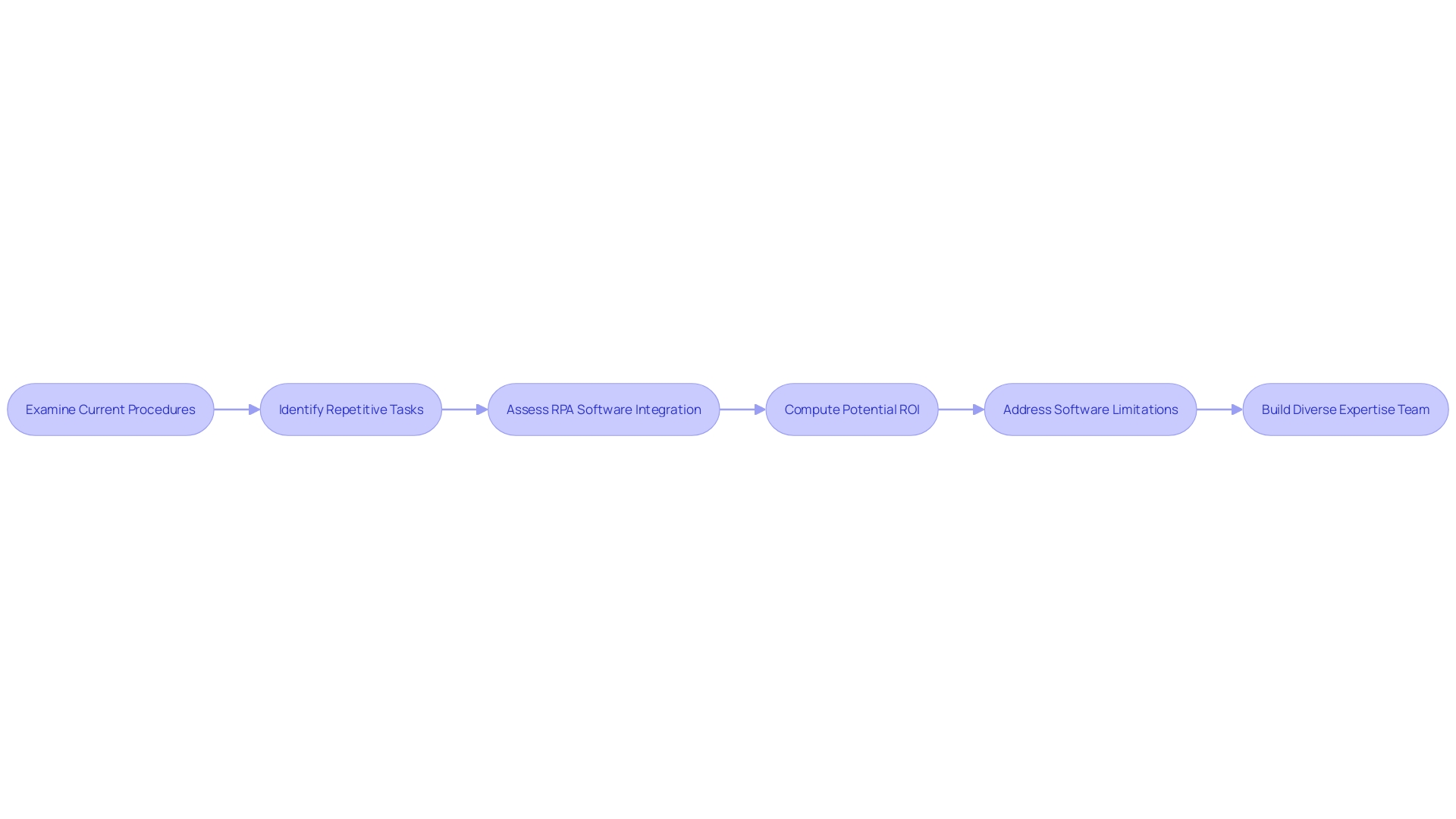
Assessment and Planning
Before immersing oneself in the realm of Robotic Process Automation (RPA), it is crucial to conduct a thorough evaluation of current procedures to identify the ideal candidates for streamlining. This involves a meticulous evaluation of manual tasks to determine which can be effectively replaced by RPA, thus addressing inefficiencies and streamlining operations. To make this easier, posing the correct inquiries is crucial: Which manual actions are ready for automation? What are the inefficiencies within these procedures that RPA can resolve? And what are the expected time and financial investments needed to incorporate RPA into each procedure?
Once you have determined the procedures that have the most potential for improvement, the subsequent action is to thoroughly outline these procedures, paying attention to all parties and systems involved, such as inventory control or customer support platforms. With this information, you can assess each process’s complexity against the potential return on investment (ROI). It’s often the simplest tasksâthose that are manual, repetitive, and costlyâthat present the most immediate and impactful opportunities for streamlining processes.
For instance, automating identity verification and basic order inquiries can deliver quick wins and significant improvements in customer service efficiency. By concentrating on these easily attainable benefits rather than the more intricate, state-of-the-art applications, companies can make significant advancements in their journey towards mechanization.
Embracing RPA is not just about the technology; it’s a strategic decision that requires a clear vision and well-defined success metrics. As emphasized in recent reports, experts in the field of mechanization, including those engaged with platforms like UiPath, stress the significance of comprehending the wider ramifications of mechanization on job satisfaction and career advancement. By staying informed and prepared, organizations can ensure that their RPA implementation not only improves operational efficiency but also supports the growth and development of their workforce.
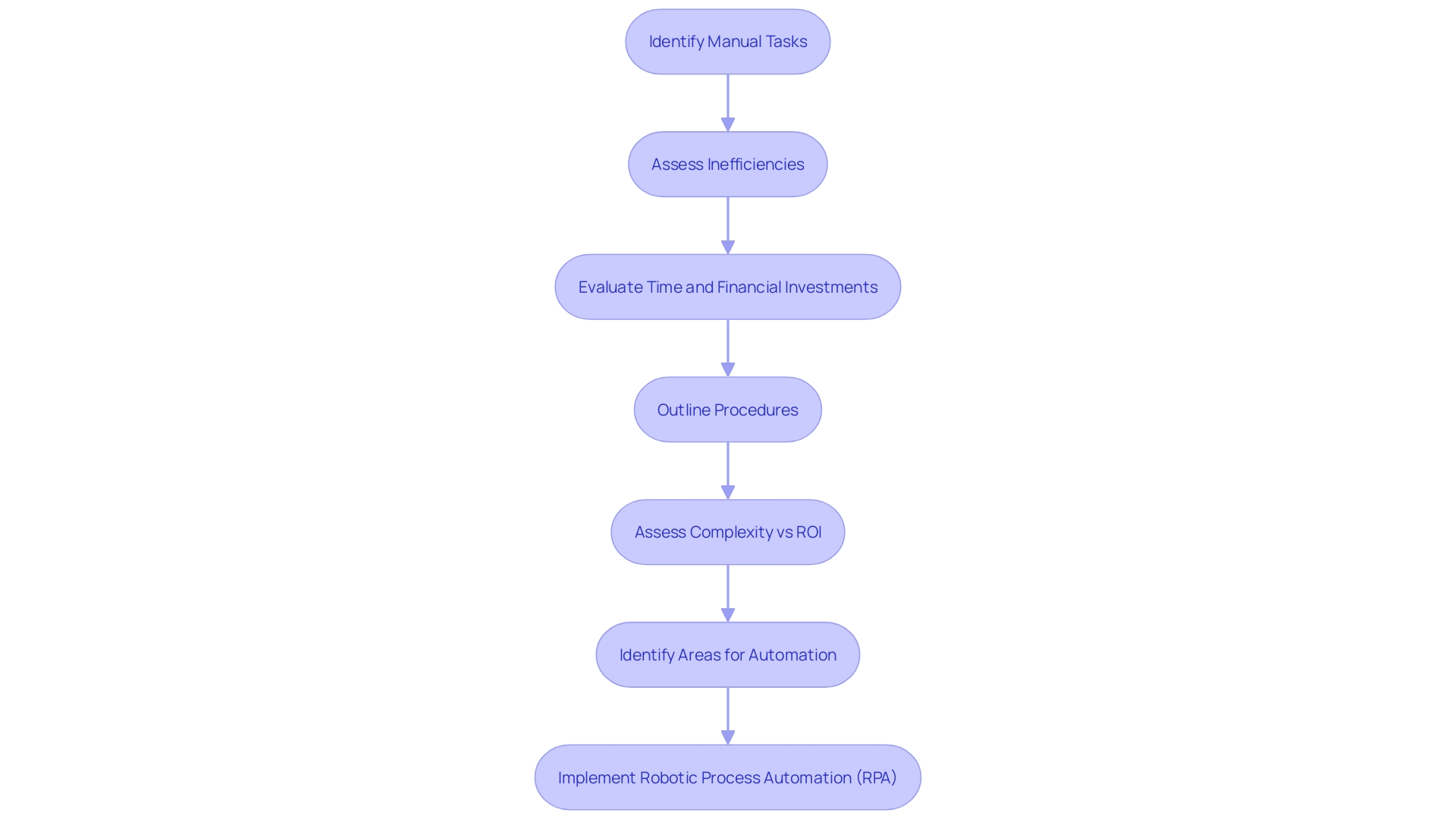
Design and Development
Robotic Process Automation (RPA) involves a meticulous approach to designing, developing, and implementing bots that can streamline and automate repetitive tasks. Drawing inspiration from a healthcare case study, the implementation begins with a thorough initial assessment to identify if the technology is secure, serves the intended purpose, and complies with relevant standards. A clinician or department initiates the process by submitting a request form, which then undergoes scrutiny by a dedicated Digital Service Team.
The team’s project manager sends out detailed questionnaires, digging deep into the reasons behind the technology adoption, how it will be used, and justifying its potential to solve existing problems. This mirrors the precision required in RPA development, where each bot is tailored to meet specific operational requirements and functions. Verifying the solution is as crucial as its development, ensuring that the script performs flawlessly and integrates seamlessly into the existing digital framework.
The importance of comprehensive testing and development is emphasized by the growing IoT and home technology markets, projected to reach an astonishing $40 billion by 2020. This growth parallels the RPA industry, where the focus is not just on creating bots but also on ensuring they deliver tangible results and maintain high security and compliance standards.
Statistics show a vibrant community of automation professionals, with a report highlighting insights from 1,639 respondents globally. This collective experience emphasizes the importance of continuous learning and adapting to integrate AI effectively into workflows. Such data points provide a backdrop for understanding the critical nature of RPA solutions that are not only well-designed but also extensively tested and ready to meet the challenges of the modern, automated workplace.

Deployment and Training
Implementing Robotic Process Automation (RPA) effectively requires a strategic approach that includes both technical deployment and personnel training. The transition begins with a meticulous assessment of digital technologies, ensuring the new RPA solution is secure and compliant. This is exemplified by the NHS’s ‘digital-assurance process,’ where technologies are rigorously evaluated for security and appropriateness before being adopted.
Once the RPA bots are configured and ready, the focus shifts to integrating them within the existing workflow. This seamless integration is crucial, as demonstrated by OnCall Health by Qualifacts, which streamlined the creation of numerous client forms by shifting from manual JSON form creation to a more efficient RPA-powered system.
Training employees is the next critical phase. A smooth transition is facilitated by equipping the workforce with the knowledge and skills to work alongside the bots. This ensures that both the technology and the staff are working in harmony, leading to improved operational efficiency and productivity. As reported in Tidio’s 2022 survey, with an 88% interaction rate between users and chatbots, the familiarity and comfort level with automated technology are increasing, highlighting the importance of a well-prepared team.
With the right measures in place, including continuous monitoring and management as recommended by the CTO and Co-Founder of Reveille Software, RPA can greatly enhance innovation. It’s a moment akin to the early days of the internet or mobile technology, where smart teams are leveraging AI to transform their operations. By automating manual tasks, businesses can offer improved customer experiences, as evidenced by the potential for RPA to help small businesses scale operations and maintain strong customer relationships.
In summary, the deployment of RPA bots and the training of employees are two sides of the same coin, both essential for the successful adoption of RPA in any industry.

Monitoring and Optimization
Ensuring the efficient functioning of systems like Robotic Process Automation (RPA) is not a set-and-forget task. It’s crucial to stay vigilant with regular performance evaluations, fine-tuning bots as needed to enhance their efficiency. This can be achieved by meticulously tracking and analyzing bot activities, promptly rectifying any errors, and making iterative adjustments to boost performance.
For instance, consider the journey of St. James Winery, a leader in the wine industry. They’ve achieved significant accolades and growth by not only perfecting their craft but also by staying ahead of the curve through innovation and optimization. Similarly, the water treatment solution developed by Optimotion for a chemical supplier illustrates how focused mechanization can address particular operational challenges while adhering to regulatory standards.
The self-governing robotics market, projected to reach a worth of USD 18.2 billion by 2032, emphasizes the crucial importance of continuous control and enhancements in mechanization. This market growth reflects the ongoing need for companies to invest in technologies that save time, increase accuracy, and enhance productivity.
Furthermore, companies are progressively acknowledging the importance of streamlining processes. According to the report, a majority of businesses are improving their mechanization methods, and more than half anticipate a profit within the initial year of execution. This emphasizes the significance of continuous monitoring and optimization to not only sustain stability but to propel the transformative influence of AI and mechanization on operational efficiency.
Common Challenges and Best Practices
Embracing Robotic Process Automation (RPA) presents a unique set of challenges that require careful consideration. Decision-makers must adopt a strategic method, identifying particular manual procedures ready for mechanization and pinpointing deficiencies that RPA can resolve. It’s not just about incorporating new technology; it’s about selecting the appropriate procedures and comprehending the time and financial commitment necessary for successful implementation.
A case in point is GrayMatter Robotics, which is revolutionizing the manufacturing industry with AI-driven robotic solutions, demonstrating the transformative power of a well-executed strategy. Their success demonstrates the significance of quality and improvement in RPA implementation.
The landscape of RPA is ever-evolving, with new applications spurring market innovation. For instance, WTWH Media’s Robotics Group provides insights into sector-specific advancements that enhance productivity and reduce costs. Moreover, the burgeoning market for mobile robotics, as highlighted at the Hannover Messe by igus, points to the growing accessibility of automation technologies for various sectors, including small and medium-sized enterprises.
The current global market for mobile robotics, valued at around $20.3 billion, is a testament to the widespread adoption and integration of RPA across industries, from logistics to hospitality. The expected market growth underscores the urgency for industries to overcome the initial challenges of RPA adoption.
These challenges, while significant, are not insurmountable. Industrial inspections, for instance, require a comprehensive examination of equipment and procedures to guarantee compliance with standards and safety. Trained inspectors using advanced methods and technologies are pivotal in this process, which is crucial across multiple sectors including power, manufacturing, and construction.
In the pursuit of modernization and streamlining, workshops and industry events serve as platforms for exchanging experiences and gaining insights into current matters in automated processes. For example, participants at a workshop on conversational interfaces shared their motivations for attending, including the desire to network, understand conversational challenges, and integrate AI into their work.
As the technological landscape develops, organizations must stay informed and proactive to utilize the full potential of RPA and overcome its challenges. By doing so, they can enhance operational efficiency and pave the way for a more innovative and productive future.
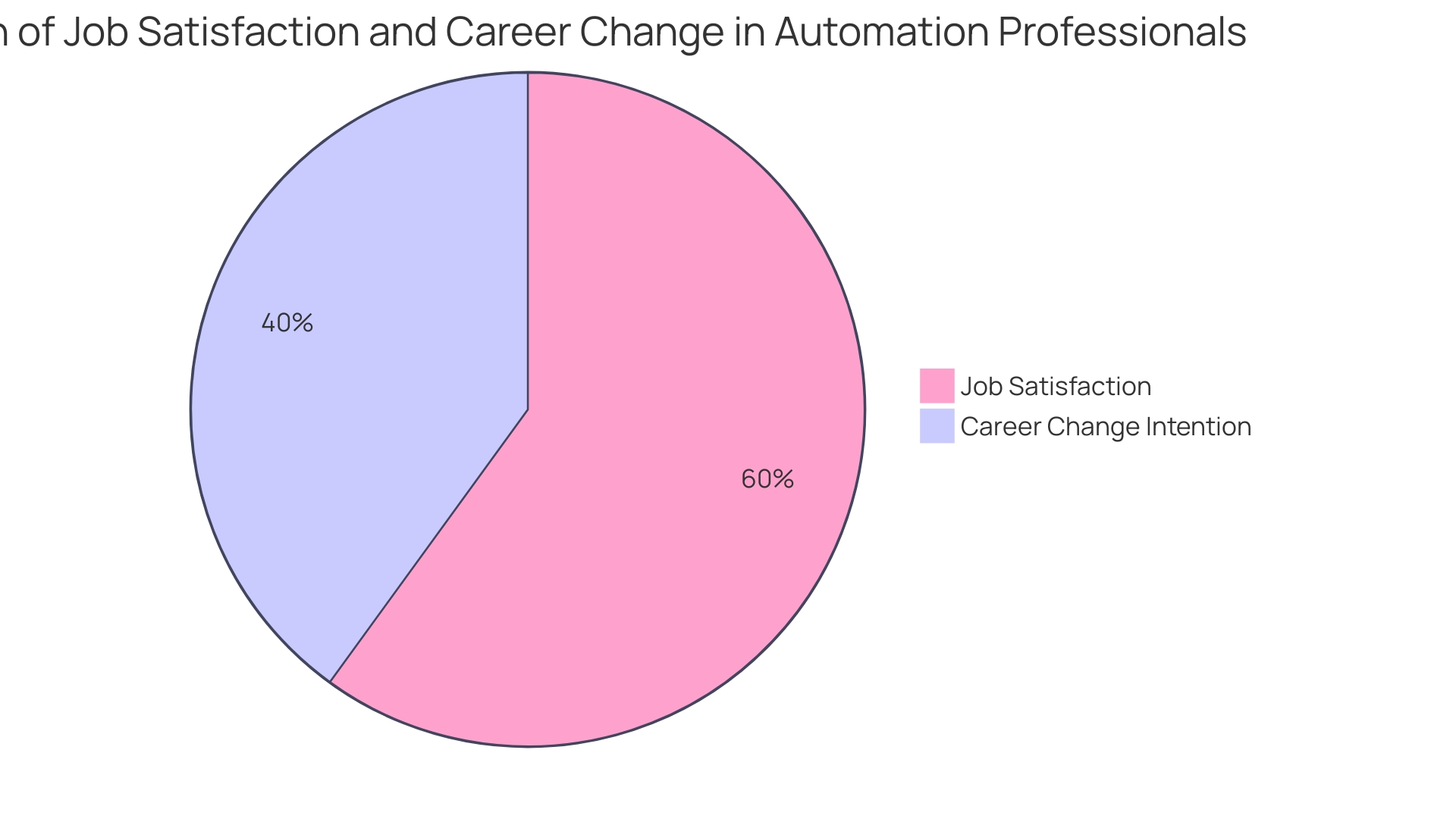
Resistance to Change
When introducing Robotic Process Automation (RPA) into an organization, one might encounter apprehension from the workforce due to concerns over job security or misunderstandings about the technology’s purpose. To navigate these challenges successfully, it’s critical to embrace a strategic approach that centers on transparency, engagement, and education.
The first phase in this procedure should involve a comprehensive evaluation of the digital technology, as demonstrated by the NHS’s experience with their Digital Service Team. Their approach includes a comprehensive review to ensure any new technology is secure, appropriate, and aligns with existing solutions, avoiding unnecessary duplication. By adopting a similar method, organizations can set a precedent for responsible and efficient RPA implementation.
Based on insights from the annual HR Technology Conference, it’s clear that the modernization journey should start with a thorough understanding of the processes ready for mechanization. This involves recognizing inefficiencies that RPA can address and evaluating the integration costs against the potential return on investment. Such strategic planning demonstrates a commitment to enhancing productivity while considering the workforce’s role in this evolution.
Leadership plays a crucial role in this transitional phase, as highlighted by the case of a large institution’s people analytics team, which identified multiple AI-driven projects during an offsite brainstorming session. This proactive stance exemplifies the importance of pinpointing demonstration projects that promise tangible business benefits.
To further mitigate resistance, it’s essential to communicate the existence of a problem clearly and the consequences of inaction. Using metrics to underscore the urgency, as suggested by experts, can help convince employees of the need for change. Additionally, fostering an environment where awareness, desire, and ability to adopt new approaches can flourish is paramount. This involves not only recognizing a better approach but also nurturing the willingness and providing the necessary skills to implement it.
Ultimately, the information from an ADP Research Institute survey and UiPath’s global survey of professionals in the field disclose a consensus on the effect of AI on employment, alongside differing viewpoints on the character of this effect. Such findings underscore the importance of understanding workforce perceptions and readiness for AI integration. By aligning RPA initiatives with these insights, organizations can better prepare their employees for the transformative changes ahead.
In general, the effective implementation of RPA depends on a comprehensive approach that considers technology evaluation, procedure choice, visionary leadership, issue communication, and workforce preparedness. By taking these factors into account, organizations can ensure a smoother transition into the automated future, with a workforce that is informed, engaged, and equipped to thrive.
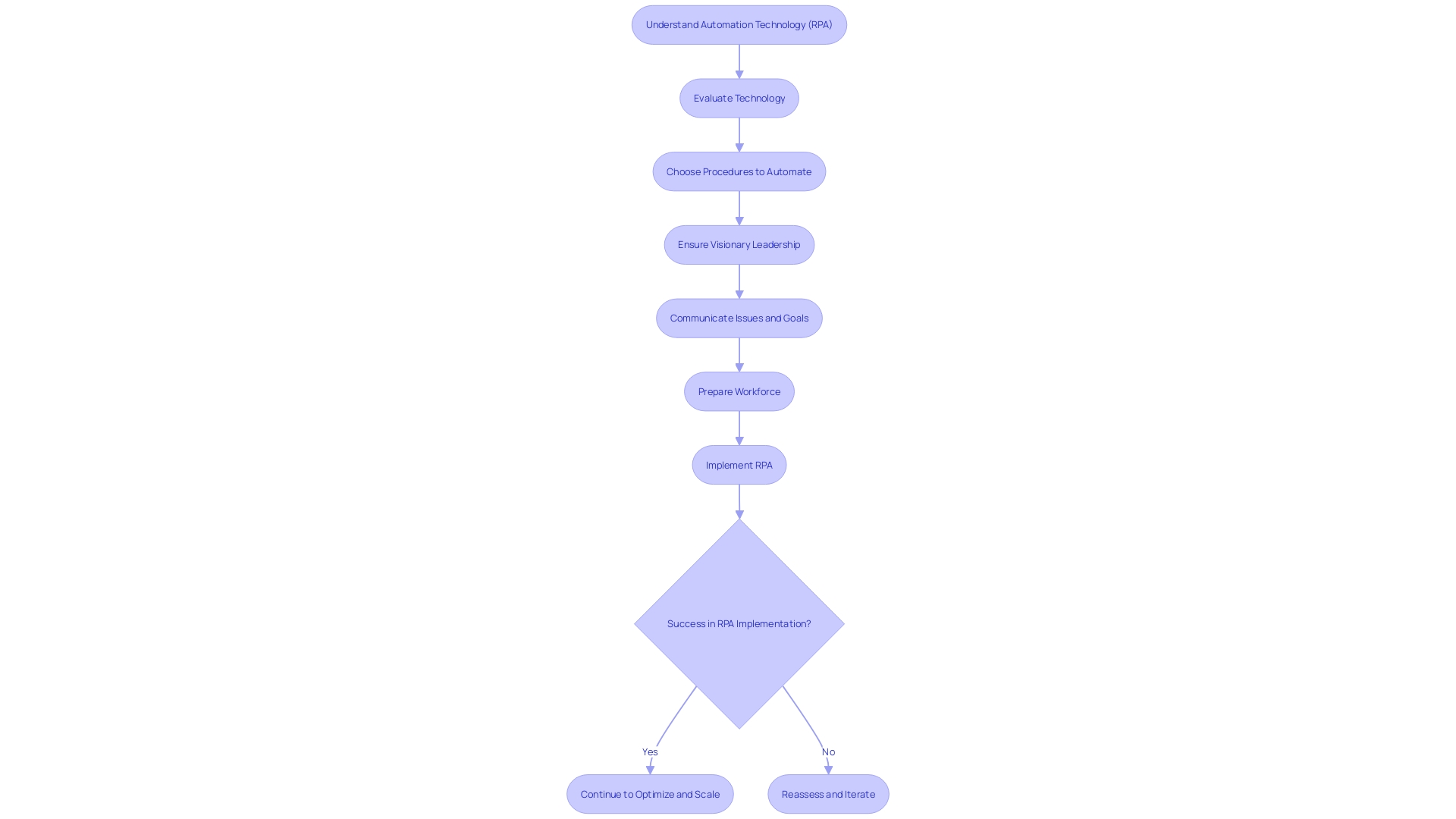
Complex Process Automations
Embracing the transformative power of intelligent technology involves more than just introducing technology into existing workflows. It’s a purposeful process that starts with a detailed analysis of which manual processes are ready for technological enhancement and what inefficiencies these technologies can resolve. Based on industry insights, the process of streamlining tasks is most effectively approached by commencing with easier assignments and progressively advancing to more intricate ones, thus giving priority to time-consuming activities that can greatly profit from mechanization. This approach not only facilitates smoother integration of RPA software but also helps to manage the transition effectively. Continuous monitoring and documentation of results are essential in ensuring that objectives are achieved and to provide valuable insights for future technological advancements. The integration of AI with RPA, known as Intelligent Automation, is revolutionizing businesses, leading to increased efficiency and more informed decision-making. Companies like Coding Crafts are at the forefront of this evolution, recognizing the need to stay ahead of the curve by offering solutions that harness the synergy of RPA and AI along with other cutting-edge technologies such as Blockchain. Meanwhile, technological advancements in AI applications, as seen in UK public transport systems and the TSA’s facial recognition program, underscore the potential of AI to enhance operational efficiency. However, these initiatives also highlight the ethical considerations and privacy concerns that must be navigated. With the introduction of tools like Copilot in Power Automate, which enables the creation of desktop flows using natural language, the barrier to entry for utilizing these technologies is being reduced, empowering a broader range of users to take advantage of them. As mechanization persists to develop, it’s evident that its achievement relies on well-informed management, strategic planning, and a cooperative human-technology partnership.
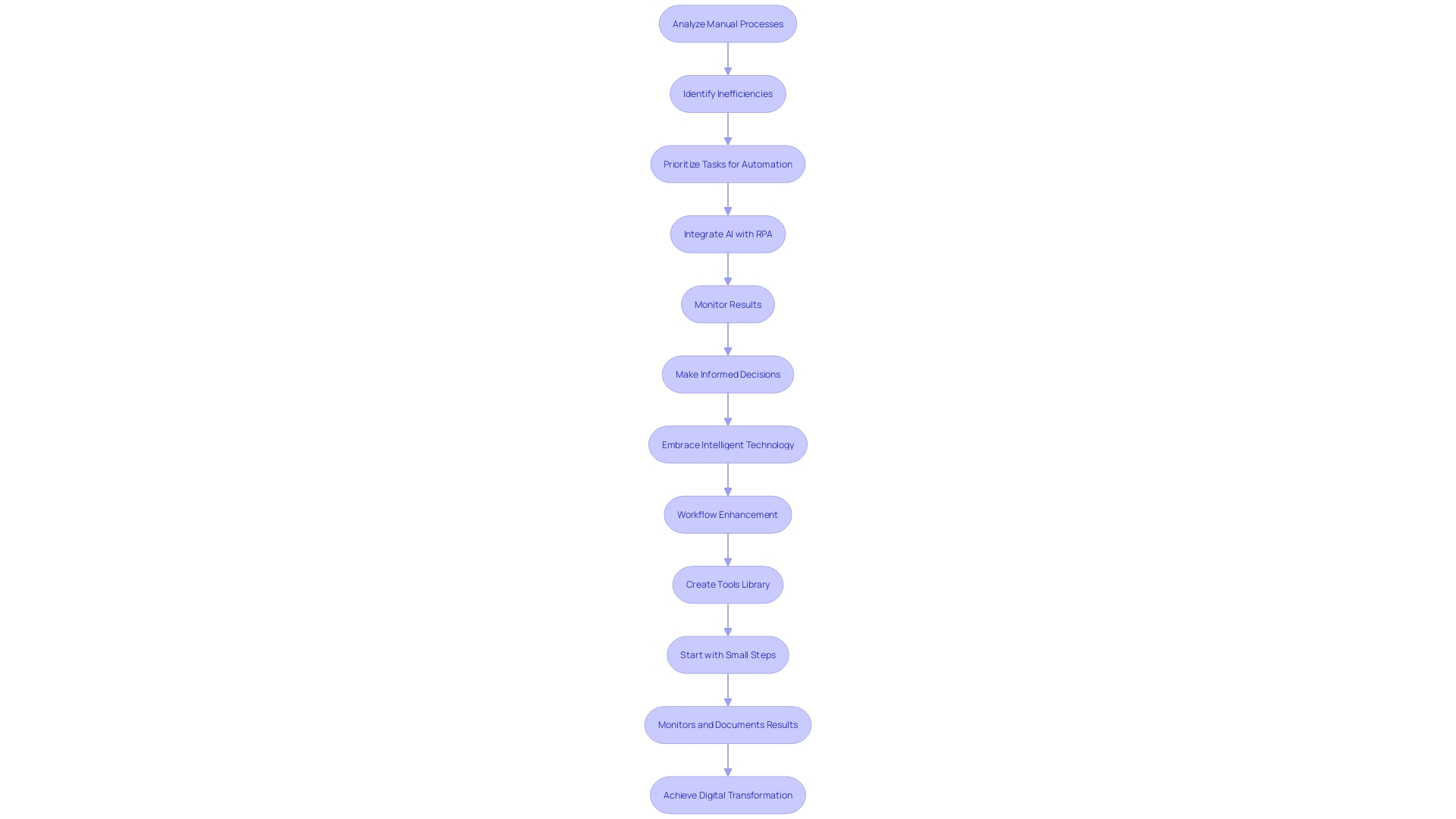
Maintenance and Support
Ensuring the longevity and effectiveness of RPA solutions necessitates a comprehensive maintenance and support strategy. The essence of such a strategy lies in the establishment of robust governance to oversee bot performance and the implementation of a dedicated team to address maintenance issues promptly.
The importance of ongoing monitoring and management is apparent in the historical context of mechanization. From the water wheel to AI, successful mechanization has always required a human touch to ensure stability and efficiency. As noted by a CTO and co-founder of Reveille Software, AI, including RPA, is designed to enhance productivity, yet it is the partnership with humans that guarantees its efficacy.
In the realm of RPA, challenges such as data ingestion and the management of various document formats can arise. These obstacles underscore the importance of a well-structured management interface that ensures accountability and seamless operation. For instance, Hiscox leveraged automation to manage the influx of client emails, achieving a 28% reduction in workload while simultaneously enhancing customer and employee satisfaction.
With predictive maintenance becoming a focal point of interest, the market, valued at $5.5 billion in 2022, is poised for growth. Businesses are increasingly concerned with data security and privacy, with 89% of companies acknowledging these as significant worries. Despite these challenges, 91% of enterprises report a reduction in repair time and unplanned downtime, highlighting the tangible benefits of predictive maintenance.
Real-world applications further illustrate the value of a solid support system for RPA. Delivery Hero, for instance, tackled the issue of frequent employee account lockouts by automating the recovery procedure, which decreased the time spent locked out and enhanced operational efficiency.
As with any technological implementation, the success of RPA hinges not only on the technology itself but also on the methodology and mindset behind its deployment. This is exemplified by companies like IFCO, which partnered with Rackspace Technology to leverage their experience and insights, ultimately enhancing customer delivery through effective RPA governance and support.
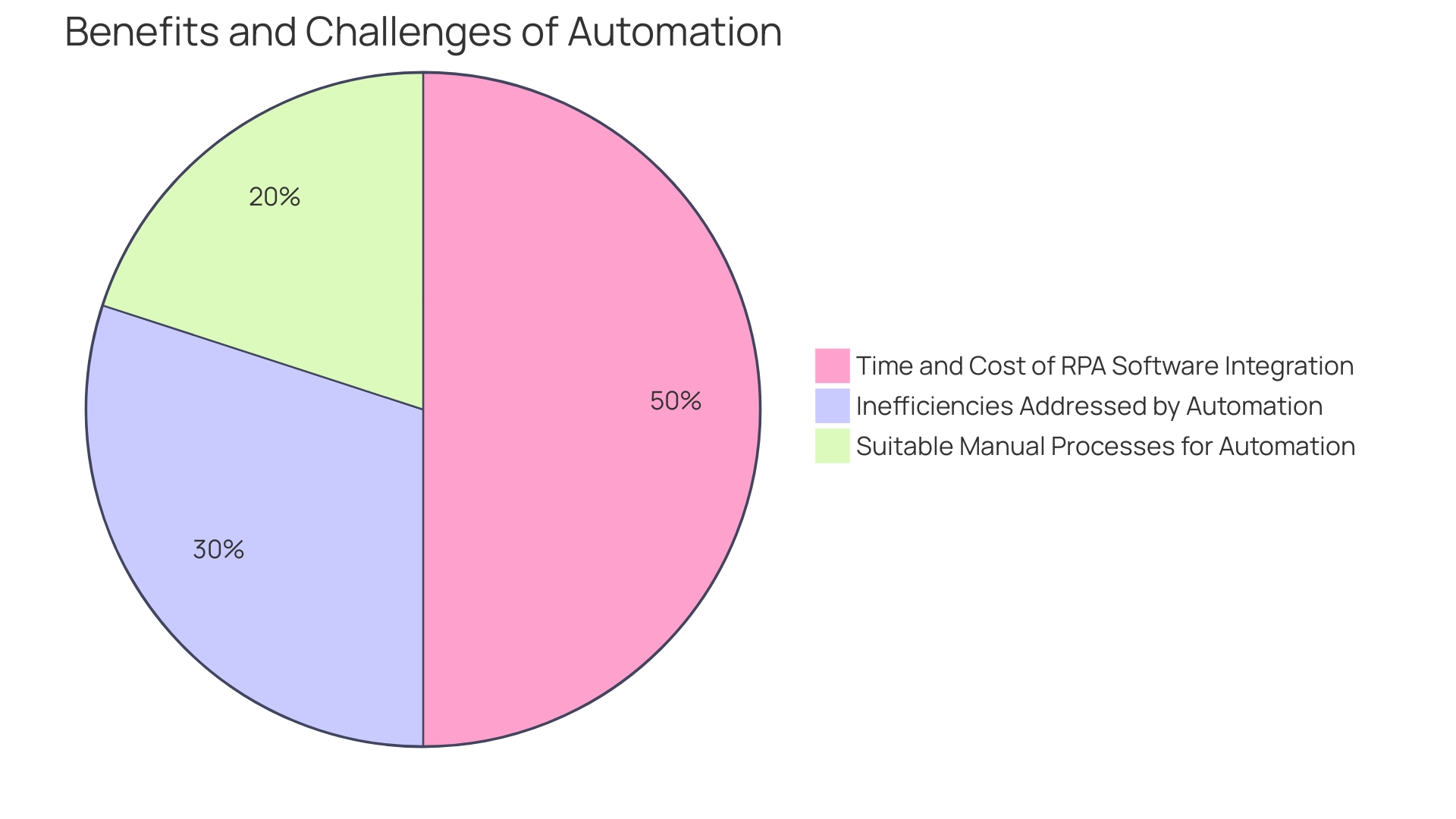
Future Trends in RPA
As the robotics landscape continues to expand and evolve, several key trends are shaping the future of this dynamic field. The integration of artificial intelligence (AI) is setting a new pace in robotics development, with AI technologies such as generative AI drawing global attention for their potential to revolutionize how businesses harness these tools.
Digital twins are emerging as a vital component in the modernization of robotics, particularly with their application in virtual models of physical systems like gantry robots. This technology allows for advanced real-time monitoring and analysis, improving planning, predictive maintenance, and ultimately resulting in increased efficiency and cost-effectiveness in manufacturing.
The versatility and adaptability of articulated robots are also noteworthy, as their design featuring rotary joints allows expansive freedom of movement, resulting in greater precision in industrial settings. This is a testament to the continued impact of the Industrial Internet of Things (IIoT) on robotics, providing a fertile ground for advancements in robotic operations.
Humanoid robots, with a rich history rooted in science fiction, are becoming increasingly sophisticated and capable of performing an array of tasks that complement human labor, rather than replace it. The deployment of programmable robots in industrial applications is accelerating, with about 3.5 million units currently operational and approximately 550,000 new units being introduced annually.
The market for Automated Guided Vehicles (AGV) and Autonomous Mobile Robots (AMR) is experiencing a robust growth trajectory. With a current valuation of around 20.3 billion US dollars, expectations are that this market will nearly double by 2028. These mobile robots are finding applications across various sectors, from intralogistics and industrial processes to service industries like healthcare and hospitality.
Recent showcases, such as the Consumer Electronics Show (CES), highlight the burgeoning interest and innovation in robotics. With over 3,200 vendors presenting cutting-edge technologies, the event underscores the sector’s vast potential and the continuous influx of new robotic solutions tailored for diverse industry needs.
In light of these trends, companies are encouraged to consider the implications these advancements may have on their respective industries and clientele. Engaging with these trends can spark new ideas and opportunities for enhancing products and services, ensuring that businesses remain at the forefront of innovation in robotics.
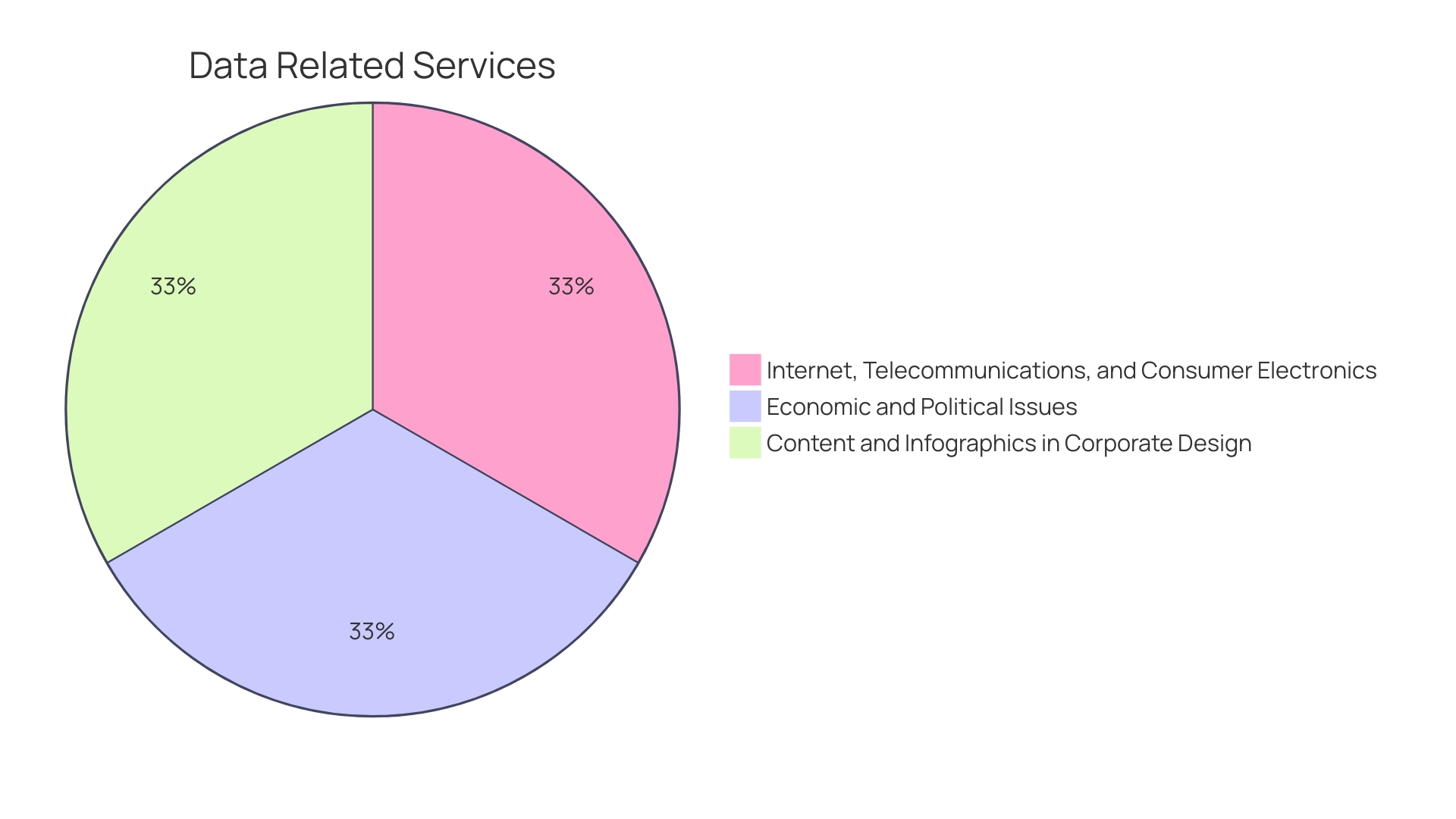
Intelligent Automation
The fusion of Robotic Process Automation (RPA) with cutting-edge artificial intelligence (AI) has led to the advent of Intelligent Automation (IA). This hybrid technology harnesses Ai’s prowess in machine learning and natural language processing, enabling robots to adeptly manage unstructured data, make informed decisions, and execute multifaceted tasks. The result is a robust automation system that elevates the capabilities of bots, allowing them to go beyond routine tasks and adapt to complex workflows.
For instance, Lindy, an AI-powered assistant, exemplifies the potential of Intelligent Automation. Designed to automate a diverse array of functions such as medical transcription, customer service, and executive support, Lindy harnessed a vast network of app integrations. Despite the formidable challenge of developing these integrations, which could have taken a year, Lindy successfully incorporated them to deliver effective task execution across crucial applications.
Moreover, Intelligent Automation’s impact is evident in its classification into four distinct categories: AI-augmented, autonomous, autonomic, and cognitive systems. These categories underscore the varying degrees of sophistication in Ai’s interaction with human activities and the environment. For instance, AI-augmented systems may sometimes demonstrate autonomous capabilities, showcasing the dynamic nature of Intelligent Automation.
Industry experts have recognized the transformative power of this technology. As per SS&C Blue Prism, Intelligent Automation goes beyond basic tasks and uses AI and generative AI to transform operations. It enables the extraction of data from documents and structures information from semi-structured or unstructured sources, thereby enhancing process execution.
In the realm of corporate mechanization, the synergy between RPA and AI in Intelligent Automation is significantly advancing operational efficiency. As quoted by a technology expert from Coding Crafts, Intelligent Automation is rapidly evolving, and staying at the forefront of this change is essential. This evolution is not just about automation; it’s about integrating additional services like Blockchain Development to bolster security and transparency in digital initiatives.
The progress in Intelligent Automation technology has a significant influence on various industries, especially for small enterprises aiming to uphold robust customer relationships. By utilizing RPA to accelerate responses to customer inquiries and guarantee the accuracy of information, organizations can greatly enhance customer satisfaction and loyalty.
Ultimately, the merging of AI capabilities with RPA is revolutionizing the landscape of digital processes, providing businesses with a potent instrument to maneuver through the intricacies of today’s digital world.
Hyperautomation
Hyperautomation goes beyond simple task execution, leveraging RPA in combination with AI, analytics, and process discovery to create a seamless, end-to-end system of automation. This approach not only accelerates the execution of processes but also enhances their accuracy and efficiency, enabling organizations to make rapid, informed decisions.
-
In practice, hyperautomation is exemplified by Holiday Extras, a European travel extras provider, which faced the challenge of creating marketing content and customer support across various languages. They required a system that could expand and adjust to their data-driven culture. By integrating intelligent automation into their operations, they were able to streamline workflows, despite the complexities of their multi-lingual requirements.
-
Similarly, Summer Health’s pediatric care services, which operate around the clock via text messaging, illustrate the time-intensive nature of administrative tasks in healthcare. By automating the creation of detailed medical visit notes, hyper automation can significantly reduce the administrative burden on healthcare providers. This allows them to spend more time on patient care, addressing the issue of burnout among medical professionals who are otherwise overwhelmed by paperwork.
-
With the integration of hyperautomation, companies are witnessing a transformation in how they conduct business. They’re able to synchronize data across various systems, enabling real-time process mining and analysis, as seen in Palantir HyperAuto’s application in the order-to-cash process. This leads to more agile decision-making, especially in complex scenarios such as managing credit blocks that can delay order fulfillment.
-
The implications of hyperautomation are also apparent in public sectors such as transportation and security. Experiments in the UK’s train stations with AI technology have demonstrated potential in enhancing safety and operational efficiency, reflecting the wider influence of automated technologies across industries. Meanwhile, concerns about the ethical use of AI, particularly in facial recognition, underscore the importance of responsible implementation.
-
This movement towards hyper-technology is emphasized by a report that highlights the perspectives of technology professionals, emphasizing the satisfaction and career development opportunities within the field. As organizations embrace this technology, the workforce is adapting, with a growing need for skills in managing and optimizing intelligent systems.
Organizations that successfully implement hyperautomation can expect not just streamlined operations, but also a workforce empowered by digital assistants, leading to an environment where both employees and technology work in concert for greater efficiency and innovation.

Cognitive Automation
Cognitive AI empowers bots with advanced capabilities that extend beyond routine tasks. It involves the application of technologies like machine learning, natural language processing, and data analytics to equip bots with the ability to comprehend, predict, and learn from data autonomously. This advancement in mechanization enables bots to assume intricate decision-making roles, similar to a human equivalent, greatly enhancing their contributions to business operations.
A convincing example illustrating the effectiveness of cognitive technology is the Enel Digital Platform’s interactive resolution procedure. Enel, an energy company, leveraged generative AI to manage IT service desk tickets, achieving a drastic reduction in resolution time from an entire day to a mere two minutes. Remarkably, about 15% of tickets were resolved automatically, without human intervention, shortening the initial response time from 9 hours to 1 minute. These impressive outcomes exemplify the efficiency and scalability that cognitive technology brings to the table.
The pursuit of efficiency through cognitive streamlining is also evident in the philosophy of industry experts like Fabio Veronese, head of ICT Industrial Delivery at Enel, who asserts that streamlining processes and boosting staff productivity are at the heart of operational excellence. With the integration of AI-assisted features into their service support platform, Enel is on a promising path to significantly reducing the effort and time to resolve cases.
Moreover, the notion of Hyperautomation emphasizes the significance of regarding such mechanization as an ongoing process that necessitates consistent supervision and improvement. This philosophy is essential for businesses to stay ahead in the rapidly evolving landscape of AI and to reap the maximum benefits of these technologies. As we embrace the future of work, Hyperautomation and cognitive technologies are acknowledged not just as technological advancements but as strategic imperatives for any forward-thinking enterprise.
In the wider scope of AI, cognitive mechanization is frequently contrasted with the notion of Artificial General Intelligence (AGI), which aims to develop machines capable of human-like thought and learning. Unlike narrow AI, which is designed for specific tasks, AGI represents a future where AI can generalize knowledge across diverse domains. This distinction emphasizes the progressive nature of cognitive mechanization, as it steps closer to AGI by providing bots with a deeper understanding and more adaptable problem-solving abilities.
Prominent figures in the field, like Shailendra Kumar, highlight the transformative capability of cognitive AI and AGI, asserting that comprehending and getting ready for their influence on society, the economy, and global viewpoints is crucial. This sentiment is echoed across various AI-focused platforms, where discussions about the implications, challenges, and opportunities of AI are encouraged to inform and inspire continued innovation in the field.
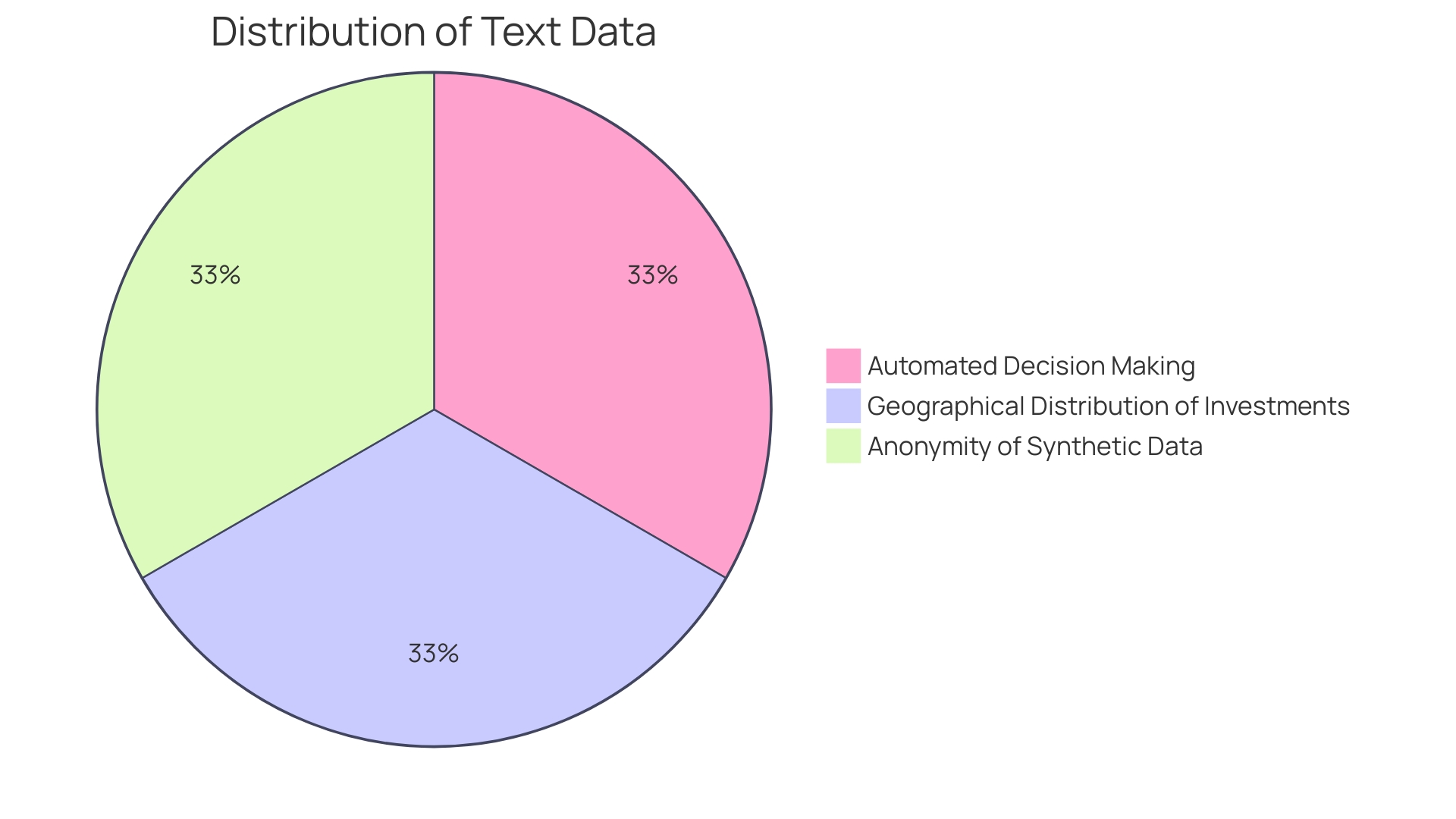
In summary
Robotic Process Automation (RPA) is a game-changing technology that allows organizations to automate monotonous, repetitive tasks, thus optimizing their operational procedures for enhanced effectiveness. It’s a leap forward in boosting productivity, achieving cost savings, and enhancing resource management. The successful deployment of RPA hinges on meticulous planning and selecting the apt tools while overcoming potential hurdles with finesse.
Exploring the realm of mechanization requires a comprehensive comprehension of both its benefits and the intricacies entailed in modernization. Leaders must make well-informed decisions by asking pivotal questions such as which manual processes are ripe for automation, the existing inefficiencies that RPA can address, and the time and financial investment required to integrate RPA software for each process identified.
Smaller enterprises, specifically, can utilize RPA to strengthen customer relationships by speeding up response times and guaranteeing consistent, accurate information delivery. Contented customers, due to timely and accurate support, are more likely to stay devoted, a crucial factor for enterprises aiming to expand operations.
Initiating the process of mechanization can commence by concentrating on straightforward, less complicated tasks, progressively advancing towards more intricate workflows. Establishing a robust library of tools is crucial to support Intelligent Automation (IA) as the technology evolves. Moreover, the ongoing monitoring and documentation of results are indispensable for assessing goal attainment and capturing insights for future initiatives.
Intelligent Automation, which marries the core principles of RPA with the transformative abilities of Artificial Intelligence (AI), signifies the evolution of business processes. It requires a lifecycle that involves identifying appropriate tasks for mechanization, involving stakeholders, and analyzing the range of the mechanization to incorporate both AI and RPA tools.
The combination of RPA and AI, referred to as intelligent integration, has emerged as a crucial catalyst in the digital transformation journey of many companies. By improving processes and efficiency and enabling more informed decision-making, intelligent technology holds the promise of unleashing a full spectrum of potential benefits.
Considering the future, intelligent mechanization is expected to continue shaping the landscape. A Forrester Research study highlights the substantial economic impact realized by investing in intelligent automation, citing a notable 73% revenue growth of overall Net Present Value (NPV) benefit and a 5.4% compound annual growth rate (CAGR) over three years for a composite organization. These compelling statistics underline the strategic value of embracing advanced technologies for businesses seeking growth and competitiveness.
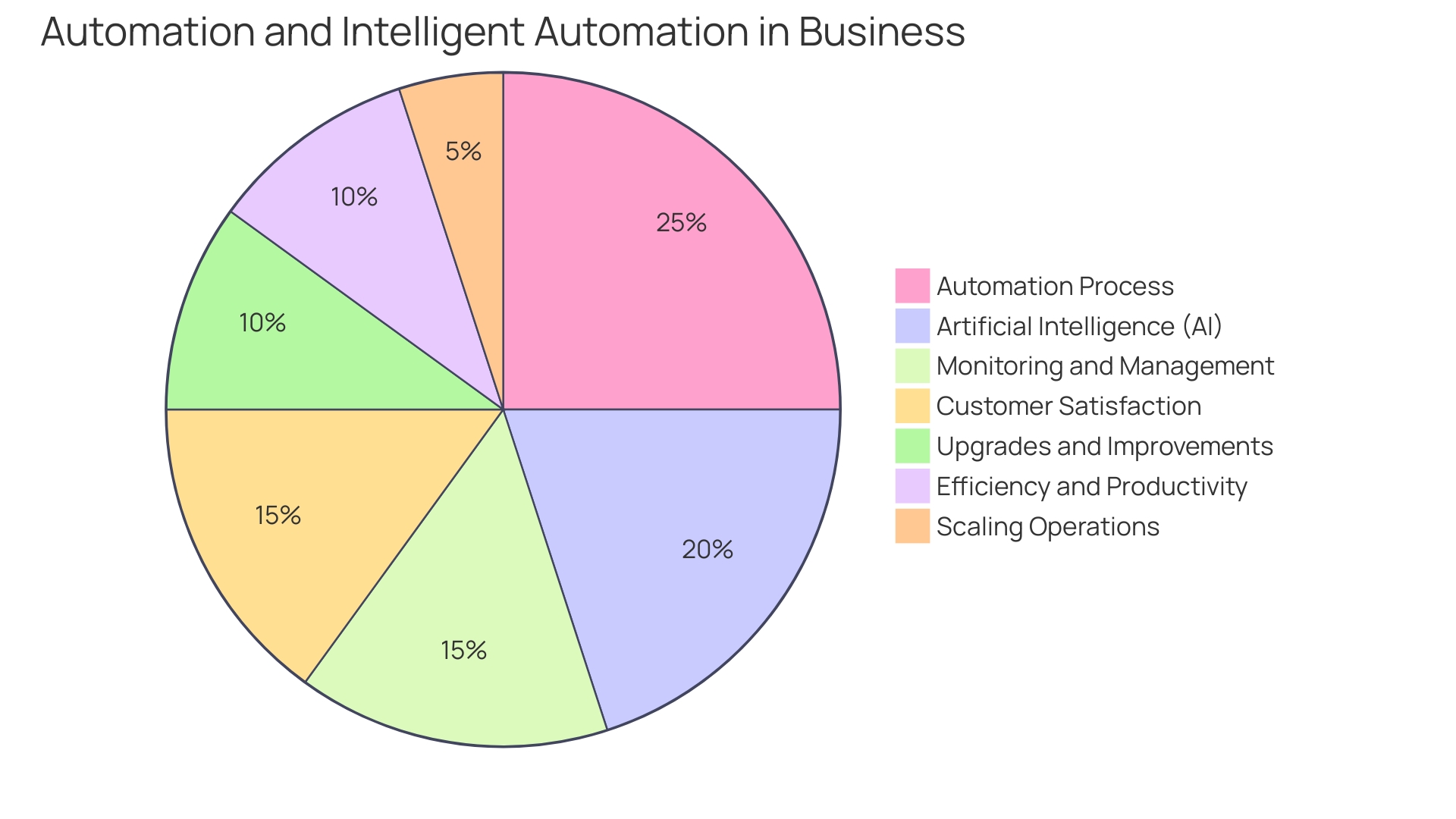
Conclusion
Robotic Process Automation (RPA) is reshaping the business world by automating routine tasks, thus freeing up human talent for higher-level strategic work. This technology has proven beneficial across various sectors, enhancing productivity and enabling growth. The rise of mobile robotics highlights RPA’s adaptability and scalability, which are essential for businesses looking to maintain agility and improve customer service.
RPA’s impact on customer service and supply chain management has been particularly noteworthy, with organizations experiencing enhanced efficiency. However, these successes hinge on selecting the right processes for automation and committing to ongoing refinement in line with changing business needs.
As RPA converges with AI, the era of intelligent automation begins, blending technology with human ingenuity for even greater economic benefits. With the promise of significant value, including improved operational efficiency and customer satisfaction, RPA stands as a pivotal element in the digital transformation of industries.
Experience the adaptability and scalability of RPA for your business and enhance customer service.

